Text
Bulgarians Mentioned in Egyptian Papyri from Fayoum
What was Ordinary in the Antiquity looks Odd today, due to the Greco-centric Fallacy of the Biased European Colonial 'Academics'
A while back, I received a brief email from a Bulgarian friend, who urgently asked me to watch a video and comment on the topic. The video offered links to a blog in Bulgarian and to an Austrian site of academic publications. The upsetting affair was the mention of a Bulgarian, or to put it rather correctly of a Bulgarian item or product which was imported in Coptic Egypt. As I understand Bulgarian to some extent, due to my Russian, I read the long presentation of the informative blog, and then replied to my friend. The video was actually a most abridged form of the article posted on the blog of a non-conventional Bulgarian blogger.

Contents
Introduction
I. Fayoum, Al Bahnasa (Oxyrhynchus), and Ancient Egyptian Papyri
II. Karl Wessely and his groundbreaking research and publications
III. Papyrus fragment 1224 of Karl Wessely's SPP VIII
IV. Βουλγαρικ- (Vulgarik-)
V. Eastern Roman Emperor Maurice's Strategicon and the Bulgarian cloaks
VI. Historical context and the Ancient History of Bulgars
VII. Historical context, the Silk Roads, and Bulgarian exports to Egypt
VIII. Academic context and the Western falsehood of a Euro-centric World History
i- the conceptualization of World History
ii- the contextualization of every single document newly found here and there
iii- the stages of historical falsification that were undertaken over the past 500 years
iv- the forgers themselves and their antiquity
v- and last but not least, several points of
a) governance of modern states
b) international alliances, and
c) the ensuing captivity of all the targeted nations, each one well-adjusted into the preconceived role that the forgers invented for it
Introduction
What follows is my response on the topic; although it concerns an undeniably very specific affair, it helps greatly in making general readership aware of how deeply interconnected the Ancient World was, of how different it was than it is presented in conventional publications, and of how many layers of fact distortion, source concealment, systematic forgery, academic misinterpretation, and intellectual falsification have been adjusted to what average people worldwide think of as 'World History'. In brief, the modern Western colonial presentation of World History, which was dictatorially imposed worldwide, is nothing more than a choice-supportive bias and a racist construct. You can also describe it as 'Hellenism', Greco-centrism or Euro-centrism.
----- Response to an inquisitive Bulgarian friend -----
My dear friend,
Your question and the associated topic are quite complex.
The video that you sent me is extremely brief and almost introductory.
Папирусът от Фаюм
youtube
However, in the description, it offers two links.
I read the article in the blog; I noticed that it was published before 12-13 years (13.10.2011). Папирусът (който щеше да бъде) с истинското име на българите?
The author seems to have been taken by surprise due to the Fayoum text, but as you will see, there is no reason for that.
The second link included in the video description offers access to Tyche, an academic annual (Fachzeitschrift) published by the Austrian Institut für Alte Geschichte und Altertumskunde, Papyrologie und Epigraphik der Universität Wien. But this is an introductory web page (https://tyche.univie.ac.at/index.php/tyche) that has links to many publications, which you can download in PDF.
You must not be surprised by such findings; they are old and known to the specialists; there are many Bulgarian professors specializing in Ancient Greek. Some of them surely know about the text. But it is in the nature of the Western sciences that scholars do not write for the general public; it is very different from what happened in the Soviet Union and the other countries of the Socialist bloc. Reversely, all the average bloggers, who find every now and then a historical document known but not publicized, think that they discovered something incredible, but in most of the cases, we don't have anything to do with an extraordinary discovery. Simply, History has been very different from what average people have been left to believe.
I. Fayoum, Al Bahnasa (Oxyrhynchus), and Ancient Egyptian Papyri
Fayoum by the way is an enormous oasis. It has cities, towns and villages. In our times, it was one of the strongholds of Muslim Brotherhood in Egypt. Former president Muhammad Morsi got ca. 90% of the votes locally. About:
The discoveries of papyri in Egypt started mainly in the 19th c.; excavators unearthed tons of valuable documentation, unfortunately in fragmentary situation most of them; indicatively:
Such is the vastness of the documentation that either Egyptologists or Coptologists or Hellenists, there are many scholars of those disciplines who specialize in papyri only: the Papyrologists.


Fayoum map with Ancient Greek names

Fayoum Lake (above) - Wadi El Rayan waterfalls (below)


Temple of Soknopaios at Soknopaiou Nesos (Island), Fayoum (viewed from the SE)

Fayoum: a tourist destination
Another major site of papyri discovery is Oxyrhynchus (Ancient Greek name of the Egyptian site Per medjed / Oxyrhynchus is merely the Ancient Greek translation of Per medjed), i.e. the modern city of Al Bahnasa. Indicatively:
To get a minimal idea of the vastness of this field of research, go through the following introductory readings:
Cairo Fayum Papyri: http://ipap.csad.ox.ac.uk/Fayum.html
II. Karl Wessely and his groundbreaking research and publications
The fragment of papyrus that mentions in Ancient Greek an adjective, which means «Bulgarian» in English, was found in the Fayoum (you can write the word with -u or -ou). It was first published by a great scholar C. (Carl or Karl) Wessely (1860-1931).
He was one of the 10 most prominent scholars and philologists of the 2nd half of the 19th and the 1st half of the 20th c. He published a voluminous series of firsthand publications of discoveries, which was named Studien zur Paleographie und Papyruskunde (SPP). As you can guess, this took decades to be progressively materialized. Here you have an online list:
Unfortunately, the volume VIII (Leipzig 1908), which is mentioned in the article of the blog, is missing in the wikisource list!
No problem! You can find the PDF in the Internet Archives site. Here is the link:
You will find the text’s first publication on page 189 of the book; this is the page 63 of 186 of the PDF. This means that you will find this indication at the bottom of the PDF: 189 (63 / 186).
This volume, as stated on p. 7, contains «Griechische Papyrusurkunden kleineren Formats», i.e. Greek papyri documents of smaller format. If you find it strange that on the first page of the main text (137 (11 / 186) as per the PDF), the first text has the number 702, please remember that this is an enormous documentation published in the series of volumes (SPP) published by Wessely between 1900 and 1920.
III. Papyrus fragment 1224 of Karl Wessely's SPP VIII
As you will see, the text slightly differs from what is shown in either the blog article or the video. It is indeed the 1224 papyrus fragment as per the enumeration of the publication. Similarly to many other cases, most of the text is lost; this is quite common. Few things are easy to assess, if you through the entire volume; apparently the background reflects Coptic Egypt, which means that all the texts date between the early 4th and 7th c. CE. This is clearly visible because the dating system is based on indiction, which was a Roman system of periodic taxation and then chronology. About: https://en.wikipedia.org/wiki/Indiction
This Latin word was accepted in Greek: ινδικτιών,
We can also understand that the person, who wrote this specific document, was following (not the Julian calendar but) the Coptic calendar, because on the 8th line the remaining letters αρμουθί (armouthi) help us reconstitute the well-known Coptic month of Pharmouthi (or Parmouti) which corresponds to end March-beginning April (in the Julian calendar) or April and early May in the Gregorian calendar. In Arabic, it is pronounced 'Bermouda' (unrelated to the Bermuda islands).
About: https://en.wikipedia.org/wiki/Parmouti
It has to be noted that the pagan Greek calendar was abolished, and that the use of 'Greek' ('Alexandrine Koine, to be correct) in the Fayum papyri texts and elsewhere does not imply 'ethnic' membership but rather religious affiliation (in this case, in contrast to Coptic).
About the Coptic calendar:
In addition, you can see the first letter of the word «indiction» ι (ι) after Pharmouthi.
Apparently, this papyrus documented a transaction effectuated by a certain Cyril (Cyrillus / Κύριλλος). Only the letters «rill» (ριλλ) are saved, as you can see, but the high frequency of the name among the Copts makes of this word the first choice of any philologist. By the way, the name is still widely used among today’s Copts as «Krulos».
I fully support Wessely’s reconstitution of the document on lines 7, 10 and 11.
Line 7 (εγράφη out of εγρα-), i.e. «it was written»
Line 10 (απείληφα out of -ειλ-), i.e. «I received from»
Line 11 (και παρών απέλυσα out of -αρω-), i.e. «I set free by paying a ransom or I disengaged or I released». Details:
Now comes a thorny issue, because on line 6, Wessely wrote «λαμιο(υ)» (: lamio reconstituted as lamiu), and went on suggesting a unique term «χαρτα-λαμίου» (charta-lamiou). This is not attested in any other source. Λάμιον (lamium) is a genus of several species of plants, whereas Lamios (Λάμιος) is a personal name. About:
Also: (ἡμι-λάμιον) https://www.perseus.tufts.edu/hopper/text?doc=Perseus%3Atext%3A1999.04.0057%3Aentry%3Dh(mila%2Fmion
But «χαρτα-λαμίου» (in Genitive declension) is a hapax. Still the opinion of the first explorer and publisher is always crucial; but as in many other cases, these people publish such an enormous volume of documentation that they do not have enough time to explain their suggestions and reason about their choices. To them, publishing hitherto unpublished material is undisputedly no 1 priority.
Other scholars attempted a different approach; they hypothetically added «υιός» (yios), i.e. «son», before λαμίου (Lamiou)
Personally, I find it highly unlikely. First, I most of the times support the first explorer’s / publisher’s approach.
Second, I believe that those, who add «υιός» (yios), i.e. «son» on line 6, are forced to reconstitute Βουλγαρικ̣[ὸς on line 5. This is most probably wrong.
But Wessely did not attempt something like that, preferring to leave the only saved word on line 5 as it is «Βουλγαρικ̣».
Now, what stands on lines 1 to 4 is really too minimal to allow any specialist to postulate or speculate anything. Perhaps there was something «big» mentioned on line 3 («-μεγ-»/«-meg-»), but this is only an assumption. Also, on line 4, we read that something (or someone) was (or was sent or was bought) from somewhere, because of the words «από της» (apo tis), i.e. «from the» (in this case, «the» being the feminine form of the article in Genitive declension).
IV. Βουλγαρικ- (Vulgarik-)
Now, and this is the most important statement that can be made as regards this fragment of papyrus, the word that stands on line 5 is undoubtedly an adjective, not a substantive! This is very clear. This means that the word is not an ethnonym. In English, you use the word «Bulgarian», either you mean a Bulgarian man (in this case, it is a noun) or a Bulgarian wine (on this occasion, it is an adjective). Bulgarian is at the same time a proper noun and an adjective in English.
However, in Greek, there is a difference when it comes to names of countries and nations. When it is a proper noun (substantive), you say «Anglos» (Άγγλος), «Sikelos» (Σικελός), «Aigyptios» (Αιγύπτιος), etc. for Englishman, Sicilian man, Egyptian man, etc. But you say «anglikos» (αγγλικός), «sikelikos» (σικελικός), «aigyptiakos» (αιγυπτιακός), etc. for adjectives of masculine gender.
Discussing the word attested on line 5 of the papyrus fragment 1224 of Karl Wessely's SPP VIII, I have to point out that in Ancient 'Greek' and in Alexandrine Koine, there is a vast difference between Βούλγαρος (Vulgaros) and βουλγαρικός (vulgarikos).
The first denotes a Bulgarian national, someone belonging to the ethnic group / nation of Bulgars and/or Bulgarians. At this point, I have to also add that these two words in English are a modern academic convention to distinguish Proto-Bulgarians (Bulgars) from the Bulgarians, who settled in the Balkan Peninsula. However, this distinction did not exist in Late Antiquity Greek texts and in Eastern Roman texts.
The second is merely an adjective: βουλγαρικός (vulgarikos), βουλγαρική (vulgariki), βουλγαρικόν (vulgarikon) are the three gender forms of the adjective: masculine, feminine and neutral.
So, as the preserved part of the word being «βουλγαρικ-» (vulgarik-), we can be absolutely sure that the papyrus text mentioned a Bulgarian item (a product typical of Bulgars or an imported object manufactured by Bulgars) — not a Bulgarian man.
All the same, it makes sure the following points:
a. in 4th-7th c. CE Egypt, people imported products that were manufactured by Bulgars in their own land (Bulgaria).
b. since the products were known, imported and listed as «Bulgar/Bulgarian», people knew the nation, which manufactured them, and its location.
c. considering the magnitude of the documentation that went lost, we can safely claim that there was nothing extraordinary in the arrival of Bulgar/Bulgarian products in in 4th-7th c. CE Egypt.
d. the papyrus in question presents the transaction in terms of «business as usual».
This is all that can be said about the papyrus text, but here ends the approach of the philologist and starts the viewpoint of the historian. However, before presenting the historical context of the transaction recorded in the fragmentarily saved papyrus from Fayoum, I have to also discuss another issue, which was mentioned in the blogger's interesting discussion.
V. Eastern Roman Emperor Maurice's Strategicon and the Bulgarian cloaks
Of course, as anyone could expect, several historians and philologists would try to find parallels to the mention of Bulgarian imports made in this papyrus fragment.
And they did. In his presentation, the blogger already mentioned several academic efforts. So, the following paragraphs, which are to be found almost in the middle of the article (immediately after the picture), refer to two scholarly efforts to establish parallels:
«Публикуван е за пръв път от SPP VIII 1124, Wessely, C., Leipzig 1908 и по - късно препубликуван от Diethart, в публикация с многозначителното заглавие „Bulgaren“ und „Hunnen“, S. 11 - 1921. Въпреки това папирусът не стига много бързо до родна публика.
"По пътя" един учен, Моравч��к, стига и по - далеч при превода. Той разчита в откъсите и думата "Пояс" и включва в теорията ново сведение(Mauricii Artis mllltaris libri duodecim, Xll (ed. Scheffer), p. 303) , където се казва, че пехотинците трябвало да носят "ζωναρία bм λιτά, xal βουλγαρική cay ία" - т.е. смята, че става дума за носен в Египет от военните "български пояс"(сведенията за публикациите дотук са по Иван Костадинов).
Вдясно виждате лична снимка. Коптска носия от 4-ти век н.е. Пази се в етнографския музей на александрийската библиотека. По необходимост за пустинния климат е от лен. Оттам вече аналогиите оставям изцяло на вас.
Папирусът "идва в България" късно. По спомени казвам ,че мисля, че първият публикувал го е доста уважаваният Иван Дуриданов, който с радост представя на българската публика вече 4 деситилетия предъвкваният от западната лингвистика български папирус. Той публикува радостна статия, с която приветства откритието».
Certainly, Gyula Moravcsik (1892-1972) and Johannes Diethart (born in 1942) proved to be great scholars indeed. About:
The adjective Vulgarikos, -i, -on («Bulgarian» in three genders) is attested in a famous Eastern Roman text, which is rather known under the title «Maurice’s Strategicon»; this was a handbook of military sciences and a guide to techniques, methods and practices employed by the Eastern Roman army. It was written by Emperor Maurice (Μαυρίκιος- Mauricius /reigned: 582-602) or composed according to his orders. About:
I did not read Moravcsik’s article, but I read the Strategicon; it does not speak of «Bulgarian belts», but of «Bulgarian cloaks». In this regard, the blogger mentions a very old edition of the text, namely Mauricii Artis mllltaris libri duodecim, Xll (ed. Scheffer), p. 303). This dates back to 1664:
At those days, all Western European editions of Ancient Greek texts involved Latin translations. Scheffer's edition of the Strategicon can be found here:
https://books.google.ru/books?id=77NODQEACAAJ&printsec=frontcover&hl=ru&source=gbs_ge_summary_r&cad=0#v=onepage&q&f=false (page 303)
George T. Dennis' translation (1984) makes the text accessible to English readers:
In the 12th chapter, which is the last of the Strategicon, under the title "Mixed Formations, Infantry, Camps and Hunting", in part I (Clothing to be Worn by the Infantry), on page 138 (University of Pennsylvania Press), the word σαγίον (sagion) is very correctly translated as "cloak". The author refers to "βουλγαρικά σαγία" (Latin: sagia Bulgarica) in plural; this is rendered in English "Bulgarian cloaks", which are thought to be very heavy. Already, the word σαγίον (sagion) is of Latin etymology. About:
and https://www.oxfordreference.com/display/10.1093/oi/authority.20110803100436640
Also: https://greek_greek.en-academic.com/151302/σαγίον
In that period and for more than 1000 years, what people now erroneously call «Medieval Greek» or «Byzantine Greek» (which in reality is «Eastern Roman») was an amalgamation of Alexandrine Koine and Latin. There were an enormous number of Latin words written in Greek characters and in Alexandrine Koine form. Indicatively: https://en.wikipedia.org/wiki/Koine_Greek
At this point, I complete my philological commentary on the topic. I read the Strategicon of Emperor Maurice when I was student in Athens in the middle 1970s.
I did not remember the mention of Bulgarian cloaks, but I know however that the Bulgars, who founded the Old Great Bulgaria, appear in Eastern Roman texts at least 100 years before the purported establishment and growth of that state (632–668). The academic chronology for the First Bulgarian Empire may be correct (681–1018), but the dates given for the Old Great Bulgaria and the Volga Bulgaria (late 7th c.–1240s) are deliberately false. General info:
https://en.wikipedia.org/wiki/Old_Great_Bulgaria and https://en.wikipedia.org/wiki/First_Bulgarian_Empire
https://en.wikipedia.org/wiki/Volga_Bulgaria and https://en.wikipedia.org/wiki/Bulgars#Etymology_and_origin
VI. Historical context and the Ancient History of Bulgars
It is now time for me to briefly discuss the historical context within which the aforementioned topics took place. Let’s first ask some questions:
Is it strange that a Fayoum papyrus of the 3rd-7th c. CE mentions Bulgarian products that arrived in Egypt?
Is it odd that in Emperor Maurice’s Strategicon we find a mention of Bulgarian cloaks used or not used by the Eastern Roman army?
In both cases, the response is «no»!
From where did these Bulgarian products come?
Where did Bulgars (or Bulgarians) live at the time?
My personal response is somehow vague: they came from some regions of today’s Russia’s European soil, either in the southern confines (the Azov Sea, the northern coast of the Black Sea, and the North Caucasus region) or in the area of today’s Tatarstan and other lands north-northeast of the Caspian Sea.
It is not easy to designate one specific location in this regard, and this is so for one extra reason: it seems that there were several tribes named with the same name, and they were distinguished among themselves on the basis of earlier tribal affiliations, which may go back to the Rouran Khaganate (330-555 CE). There are actually plenty of names associated with the early Bulgars, notably the Onogurs, the Kutrigurs, etc. About:
Many readers may be taken by surprise because I go back easily from the time of the Old Great Bulgaria (630-668 CE) to that of the Rouran Khaganate and the Huns. All the same, there is no surprise involved in this regard. Western European historians deliberately, systematically and customarily underestimate across the board the value of Oral History and attempt to dissociate Ethnography from History; these approaches are wrong. It is quite possible that, from the very beginning of the establishment of Rouran Khaganate, many tribes, clans or families (which later became nations) started migrating. The very first Bulgars (Bulgarians) may have reached areas north of the Iranian borders in Central Asia or in Northern Caucasus much earlier than it is generally thought among Western scholars. See indicatively:
Now, the reasons for which I intentionally date the first potential interaction of Bulgars/Bulgarians with other tribes (or nations) in earlier periods are not a matter of personal preference or obstinacy. There is an important historical text named «Nominalia of the Bulgarian Khans». It has not been duly comprehended let alone interpreted thus far. About:
Three Russian copies of the text have been saved (in Church Slavonic); they date back to the 15th and 16th c. They are generally viewed as later copies of a potential Old Bulgarian text of the 9th c. Other specialists also pretend that there may/might have been an even earlier text, in either Eastern Roman («Medieval Greek») or Bulgar, which was eventually a stone inscription.
In this document, the highly honorific title «Knyaz» (Князь) is given to Asparuh (ca. 640-700) and to his five predecessors. I must add that the said document was always an intriguing historical source for me due to two bizarre particularities to which I don't think that any scholar or specialist gave due attention, deep investigation, and persuasive interpretation.
First, the antiquity of the document is underscored by the fact that the early Bulgar calendar, which is attested in this text, appears to be an adaptation of the Chinese calendar. This fact means that the primeval Bulgars, when located somewhere in Eastern Siberia or Mongolia, must have had dense contacts with the Chinese scribal and imperial establishment; perhaps this fact displeased other Turanian-Mongolian tribes of the Rouran Khaganate and contributed to the emigration of those «Ur-Bulgaren». The next point is however more impactful on our approach to the very early phase of the Bulgars.
Second, although for most of the rulers immortalized in the historical document, the duration of their lifetimes or tenures are of entirely historical nature (involving brief or long periods of 5 up to 60 years of reign or lifetime), the two first names of rulers are credited with incredibly long lifetimes. This is not common; actually, it does not look sensible; but it is meaningful.
More specifically, Avitohol is said to have lived 300 years, whereas Irnik is credited with 150 years. But we know who Irnik was! Irnik or Ernak was the 3rd son of Attila and he is said to have been his most beloved offspring. Scholars fix the beginning of his reign in 437 CE, but this is still not the important point. The crucial issue with the partly «mythical» and partly historical nature of the text «Nominalia of the Bulgarian Khans» is the fact that the two early rulers, whom the Bulgarians considered as their original ancestors, are credited with extraordinarily long and physically impossible lives. General reading:
This can therefore imply only one thing: at a later period, when the earlier memories were partly lost for various reasons, eventually because of the new environment namely the Balkan Peninsula, in which the then Bulgars were finding themselves, Avitohol and Irnik were retained as the leading figures of ruling families, and not as independent rulers. Consequently, the dates given for their lives were in fact those of their respective dynasties. It was then that the very early period of Bulgar History was mythicized for statecraft purposes, mystified to all, and sanctified in the national consciousness.
Many Western scholars attempted to identify Avitohol with Attila, but in vain; I don’t think that this attempt can be maintained. So, I believe that the Bulgars were one of the noble families of the Huns (evidently involving intermarriage with Attila himself), and that before Attila, the very earliest Bulgars were ruled by another dynasty which had lasted 300 years. But if it is so, we go back to the times of the Roman Emperor Trajan (reign: 98-117 CE), Vologases III of Arsacid Parthia (110–147 CE) and the illustrious Chinese general, explorer and diplomat Ban Chao (32-102 CE) of the Eastern Han dynasty. About:
The latter fought for 30 years against the Xiongnu (Hiung-nu/匈奴, i.e. the earliest tribes of the Huns, consolidated the Chinese control throughout the Tarim Basin region (today's Eastern Turkestan or Xinjiang), and was appointed Protector General of the Western Regions. He is very famous for having dispatched Gan Ying, an envoy, to the West in 97 CE. According to the Book of the Later Han (Hou Hanshu/後漢書), which was compiled in the 5th c. CE by Fan Ye, Gan Ying reached Parthia (Arsacid Iran; in Chinese: Anxi, 安息) and gave the first Chinese account of the Western confines of Asia and of the Roman Empire. About:
It is n this historical environment that we have to place the very early ancestors of the Bulgars.
VII. Historical context, the Silk Roads, and Bulgarian exports to Egypt
Consequently, I believe that it is more probable that the Bulgarian products of those days were first appreciated by the Iranians and later sold to Aramaeans, Armenians, Iberians and other nations settled in the western confines of the Arsacid (250 BCE-224 CE) and the Sassanid (224-651 CE) empires, i.e. in Mesopotamia and Syria, and thence they became finally known in Egypt as well.
The incessant migrations from NE Asia to Central Europe and to Africa, as a major historical event, were not separate from the 'Silk Roads'; they were part, consequence or side-effect of that, older and wider, phenomenon. Actually, the term 'Silk Roads' is at the same time inaccurate and partly; the magnificent phenomenon of commercial, cultural and spiritual inter-exchanges, which took place due to the establishment (by the Achaemenid Shah Darius I the Great) of a comprehensive network of numerous older regional trade routes, is to be properly described as 'silk-, spice-, and perfume-trade routes across lands, deserts and seas'. About: https://silkroadtexts.wordpress.com/
It has to be said that, after the Achaemenid Iranian invasion, annexation and occupation of Egypt, Sudan and NE Libya (525-404 BCE and 343-332 BCE), Iranian settlers remained in Egypt; they were known to and mentioned by the Macedonian settlers, who manned the Macedonian dynasty of Ptolemies (323-30 BCE). General info: https://en.wikipedia.org/wiki/First_Achaemenid_conquest_of_Egypt
Those Iranian settlers were called 'Persai (ek) tis epigonis' (Πέρσαι τῆς ἐπιγονῆς), lit. 'Iranian settlers' descendants'. About:
Pieter W. Pestman, A proposito dei documenti di Pathyris II Πέρσαι τῆς ἐπιγονῆς
Xin Dai, Ethnicity Designation in Ptolemaic Egypt https://www.researchgate.net/publication/329265278_Ethnicity_Designation_in_Ptolemaic_Egypt
See a text from the time of the Roman Emperor Domitian (reign: 81-96) here: https://papyri.info/ddbdp/p.athen;;23
See another text from the time of the Roman Emperor Nerva (reign: 96-98) here:
There were also in Egypt Jewish Aramaean descendants of the early Iranian settlers: "οἱ τρ(ε)ῖς | Ἰουδαῖοι Πέρσαι τῆς ἐπιγονῆς τῶν [ἀ]πὸ Σύρων κώ- | μης" (lit. Jewish Iranians, who were the descendants of an Aramaean town) - From: Database of Military Inscriptions and Papyri of Early Roman Palestine https://armyofromanpalestine.com/0140-2
Please note in this regard that the title given to the web page and the document is very wrong and extremely biased: "§140 Loan between Jews and Lucius Vettius"; the three persons who received the loan were not ethnic Jews. Their religion was surely Judaism, as it was the case of the renowned Samaritan woman with whom Jesus spoke according to the Gospels. Several other nations accepted Judaism, notably Aramaeans in Palestine, Syria and Mesopotamia (they were called 'Syrians' by the Macedonians and the Romans). It is well known that there were many clashes and strives between them and the ethnic Jews. The latter were few and lived either in Jerusalem (and its suburbs) or in Egypt (in Alexandria and many other locations) or in the centers of Talmudic academies in Mesopotamia (namely Nehardea, Pumbedita and Mahoze / Ctesiphon). About:
If I expanded on this topic, it is precisely because the merchants, who were most active across the Silk Roads, were the Aramaeans, and that is why Aramaic became almost an official language in the Achaemenid Empire of Iran, whereas at the same time it turned out to be the lingua franca alongside the trade routes. Furthermore, a great number of writing systems in Central Asia, Iran, India, and Western Asia were developed on the basis of the Aramaic alphabet. Last but not least, Arabic originates from Syriac, which is a late form of Aramaic. About:
It is therefore essential to state that the Bulgarian products, which (either from North Caucasus and the northern coastlands of the Black Sea or from the regions around the north-northeastern shores of the Caspian Sea) reached Egypt (via most probably North Mesopotamia, Syria and Palestine), were transported on camels owned by Aramaean merchants and due to caravans organized and directed by Aramaeans.
It is also noteworthy that, during the Arsacid times, several buffer-states were formed between the eastern borders of the Roman Empire and the western frontiers of Parthia: Osrhoene, Sophene, Zabdicene, Adiabene, Hatra, Characene, Elymais, Gerrha (the illustrious port of call and major trade center of the Persian Gulf that rivaled with Alexandria in the Mediterranean), the Nabataean kingdom, and the short-lived but most formidable Tadmor (Palmyra). This situation favored the world trade between East and West, as well as North and South. General info:
The great rivalry and ferocious antagonism between the Romans (and later the Eastern Romans) and the Iranians after the rise of the Sassanid dynasty (224 CE) did not affect in anything the good relations and the trade among Egyptians, Aramaeans, and Iranians; there were numerous Aramaean populations in both empires, so, we feel safe to conclude that any products from lands north of Caucasus mountains and north of Iran were transported by Aramaeans via Palestine or Nabataea to Egypt.
There have been additional reasons for the good feelings of the Egyptians toward the Iranians, and they were of religious nature. The Christological disputes generated enmity and great animosity between
a) the Copts (: Egyptians) and the Aramaeans, who adopted Miaphysitism (also known as Monophysitism), and
b) the Eastern Romans and the Western Romans, who thought they preserved the correct faith (Orthodoxy).
One has to bear always in mind, that in order to define themselves, the so-called Monophysites (also known more recently as 'Miaphysites') used exactly the same term (i.e. 'Orthodox'), which means that they considered the Eastern Romans and the Western Romans as heretics. The patriarchates of Antioch, Alexandria and Jerusalem were split. Atop of it, other Aramaeans (mostly in Mesopotamia and Iran) accepted the preaching of Nestorius, Patriarch of Constantinople, who was also deposed as a heretic (in August 431). For the aforementioned religious reasons, the Eastern Roman armies were most loathed in Syria, Palestine, North Mesopotamia (today's SE Turkey), and Egypt as oppressors. About:
In addition, one has to take into consideration the fact that the Jews, who inhabited the eastern provinces of the Roman (and later the Eastern Roman) Empire, were also pro-Iranian and they expected that the Iranians would liberate them one day from the Roman yoke pretty much like the Achaemenid Iranian Emperor Cyrus delivered their exiled ancestors from the tyranny of Nabonid Babylonia (539 BCE).
The Axumite Abyssinian invasion of Yemen (ca. 530 CE; in coordination with the Roman Emperor Justinian I), the ensued Iranian-Axumite wars, the Iranian invasion of Yemen (570 CE; known as the Year of the Elephant among the Arabs of Hejaz), and the incessant battles and wars between the Eastern Roman and the Sassanid Iranian armies were closely watched by all populations in Egypt. The third Iranian conquest of Egypt (618 CE) was a matter of great jubilation for Copts and Jews; Egypt was annexed to Iran for ten (10 years), before being under Eastern Roman control again for fourteen years (628-642 CE) and then invaded by the Islamic armies. General info:
Indicative of the good Egyptian feelings for the Sassanid emperors and Iran is a tapestry weave found by Albert Gayet in his 1908 excavations in Antinoe (also known as Antinoöpolis, i.e. the town of Sheikh Ibada in today's Egypt); this is a textile fragment of legging that dates back to the late 6th and early 7th c. (Musée des Tissus, in Lyon-France; MT 28928). It features the scene of an unequal battle that has been identified as one of the engagements between the Sassanid and the Axumite armies in Yemen; Iranian horse-archers are depicted at the moment of their triumph over Abyssinian infantry opponents, who appear to be armed with stones. In the very center of the scene, an enthroned figure was often identified with the great Iranian Emperor Khosrow (Chosroes) I Anushirvan (Middle Persian: Anoshag ruwan: 'with Immortal Soul'), who was for Sassanid Iran as historically important as Justinian I, his early rival and subsequent peace partner, for the Roman Empire. About:
This was the wider historical context at the time of the arrival of the first Bulgarian exports to the Sassanid Empire of Iran, the Eastern Roman Empire, and Egypt more specifically. And the Bulgarian cloaks, as mentioned in Maurice’s Strategicon, make every researcher rather think of heavy winter cloaks, which were apparently not necessary for the Eastern Roman soldiers, who had to usually fight in less harsh climatological conditions. It is possible that those heavy cloaks were eventually used by the Iranian army when engaged in the Caucasus region, and thence they were noticed by the Eastern Romans.
With these points, I complete my philological and historical comments on the topic. However, the entire issue has to be also contextualized at the academic-educational level, so that you don't find it bizarre that not one average Bulgarian knew about the topic before the inquisitive blogger wrote his article and the YouTuber uploaded his brief video.
VIII. Academic context and the Western falsehood of a Euro-centric World History
This part does not concern the Fayoum papyri and the Strategicon of Emperor Maurice; it has to do with what non-specialists, the average public, and various unspecialized explorers do not know at all.
This issue pertains to
i- the conceptualization of World History;
ii- the contextualization of every single document newly found here and there;
iii- the stages of historical falsification that were undertaken over the past 500 years;
iv- the forgers themselves and their antiquity, and last but not least; and
v- several points of
a) governance of modern states,
b) international alliances, and
c) the ensuing captivity of all the targeted nations, each one well-adjusted into the preconceived role that the forgers invented for it.
As you can guess, one can write an encyclopedia on these topics, so I will be very brief. Attention: only at the end, you will understand that all these parameters fully precondition the topic that we already discussed, and any other that we have not yet discussed, because simply it does not exist as a standalone entity but as a fact entirely conditioned by what I herewith describe in short.
What I want to say is this: if tomorrow another Fayoum discovery brings to light a 3rd c. BCE papyrus with the mention of something Bulgarian (Voulgarikon), this will not affect in anything the prevailing conditions of the so-called academic scholarship. In other words, do not imagine that with tiny shreds of truth unveiled here and there, you are going to change anything in the excruciatingly false manner World History was written.
i- the conceptualization of World History
It may come as a nasty surprise to you, but what we know now about History is not the conclusion or the outcome of additional discoveries made one after the other over the past 400-500 years. Contrarily, it was first preconceived, when people had truly minimal knowledge of the past, and after they had forged thousands of documents and manuscripts for at least 500-600 years, long before the early historiographical efforts were undertaken during the Renaissance.
After they destroyed, concealed and rewrote tons of manuscripts of Ancient Greek and Roman historiography from ca. 750 CE until 1500 CE, Western European monks and editors, philosophers and intellectuals, popes, scientists and alchemists started propagating their world view about the assumingly glorious past of their supposedly Greek and Roman ancestors – a nonexistent past that the Renaissance people were deliberately fooled enough to believe that they had lost and they had to rediscover it. In fact, all the discoveries made afterwards, all the decipherments of numerous ancient writings, and all the studies of original material from Mesopotamia, Egypt, North Africa, Caucasus, Central Asia, China and India was duly processed and adjusted in a way not to damage or challenge in anything the preconceived scheme which was named 'World History' by the vicious and criminal Western European forgers.
This means that you should never expect 'new discoveries' to challenge the officially established dogma of the Western academia; it is not about Bulgars and the past of today's Bulgarians, Thracians, Macedonians, etc., etc., etc. It is about all. What type of position the Bulgarians, the Russians, the Turks, the Iranians, the Egyptians and all the rest occupy in today's distorted historiography had been decided upon long before the establishment of the modern states that bear those names.
ii- the contextualization of every single document newly found here and there
Any finding unearthed by anyone anytime anywhere means nothing in itself; this concerns every historiographer, truthful or dishonest. What truly matters for all is contextualization. It so did for the original forgers. Theirs was an arbitrary attempt; they contextualized the so-called 'Ancient Greece' in a way that would have been fully unacceptable, blasphemous and abominable for the outright majority of all the South Balkan populations during the 23 centuries prior to the foundation of Constantinople by Constantine the Great.
It was peremptory, partial and biased; according to the fallacious narratives of the forgers, centuries were shrunk and shortened in order to fit into few lines; moreover the schemers stretched geographical terms at will; they did not use various terms, which were widely employed in the Antiquity; they passed important persons under silence, while exaggerating the presentation of unimportant ones. This is what contextualization was for the forgers: they applied a Latin recapitulative name (Graeci) to a variety of nations, which never used this Latin term or any other recapitulative term for them; they applied a non-Ionian, non-Achaean, and non-Aeolian term (Hellenes) to them and to others; and after the decipherment of many Oriental languages, they did not rectify their preposterous mistakes, although they learned quite well that the two fake terms about those populations (Graecus and Hellene) did not exist in any other language of highly civilized nations (Egyptian, Assyrian, Babylonian, Hittite, Hurrian, Canaanite, Phoenician, Aramaic, Hebrew, Old Achaemenid Iranian).
Consequently, every other information, data and documentation pertaining to any elements of the said context was concealed, distorted or misinterpreted in order to be duly adjusted to the biased context that had been elaborated first.
iii- the stages of historical falsification that were undertaken over the past 500 years
Following the aforementioned situation, many dimensions of historical falsification were carried out and can actually be noticed by researchers, explorers, investigators and astute observers. The 'barbarian invasions' (or Migration Period) is only one of them; I mention it first because it concerns the Bulgars. Long before distorting the History of Great Old Bulgaria and that of Volga Bulgaria systematically, Western historical forgers portrayed Bulgars and many other highly civilized nations as barbarians. Why?
Because the historical forgers of the Western World hate nomads! This is an irrevocable trait of them; that's why they fabricated the fake term 'civilization' in their absurd manner: originating from the Latin word 'civitas', the worthless and racist term 'civilization' implies that you cannot be 'civilized' unless you are urban. This monstrous and unacceptable fact reveals the rotten roots of the hideous, vulgar, sick and villainous Western world and colonial academia.
In the Orient, there was never a cultural divide between urban populations and nomads; some nomadic tribes were considered as barbarians; that's true. But also settled populations and urban inhabitants were also considered as barbarians (like the Elamites, who were considered as inhuman by the Assyrians). The rule was that the settled nations were nomads in earlier periods. But the status of a society was irrelevant of the consideration and the esteem (or lack thereof) that others had about a certain nation. This started with the Romans and their interpretation of the South Balkan, Anatolian, and Cretan past. It was then re-utilized and modified by Western Europeans. To some extent, the papal approval was tantamount to acquisition of credentials and to promotion to 'civilized nation status'. Actually, this is today the nucleus of the whole problem concerning Ukraine.
That is why the so-called Migration Period was so terribly distorted by Western historians. Western historians deliberately preferred to stay blind and not to study the Ancient Mongol chronicles (notably the Secret History of The Mongols) in order to avoid assessing the Mongol-Turanian standards and principles of civilization. Had they proceeded in the opposite way, they would have discovered that, for the nomads, it is the settled people and the urban populations, who are barbarians, decayed and shameful.
The truth about the fallacious term 'Migration Period' is simple: there was never a migration period before 1500 CE (and certainly none afterwards), because every century was actually a migration period. Human History is a history of migrations.
The distorted linguistic-ethnographic division of the migrant nations helped forgers to dramatically increase the confusion level; as a matter of fact, there was no proper ethnic division (in the modern sense of the term) among Mongols, Turanians, Slavs and several other migrant nations. The languages change when people migrate and settle, resettle, move again, and end up in faraway places. For Muslim historians, the khan of the Saqaliba (: Slavs) was the strongest of all Turanian rulers. The arbitrary distinction of the migrant nations into two groups, namely Indo-European and Ural-Altaic/Turco-Mongolian nations was done deliberately in order to intentionally transform the face of the world and adjust it to the so-called Table of Nations, a forged text that made its way into the biblical book of Genesis in later periods (6th–4th c. BCE). General reading:
The Western academic tyranny is so deeply rooted that, irrespective of your political, ideological or philosophical affiliation (fascist, Nazi, communist, conservative, social-democrat, liberal, atheist, evolutionist, creationist, anarchist, etc.), you always have to adjust your seminars, courses, lectures, contributions, books and publications to the fallacy of Genesis chapter 10. The absurd logic of this system is the following: "since no Bulgars are mentioned in the Table of Nations, they must be a later tribe". Then, believe it or not, whatever documentation may be found in Aramaic, Middle Persian, Pahlavi, Brahmi, Kharosthi, Avestan, Sogdian, Tocharian, Chinese or other texts about the Bulgars will be deliberately presented as irrelevant to Bulgars. If a new Sogdian document is found in Central Asia (dating back to the middle Arsacid times: 1st c. CE) and there is a certain mention of Bulgars in the text, the criminal gangsters and the systematic fraudsters of the Western universities and museums will write an enormous amount of articles to stupidly discredit the document or attribute the word to anything or anyone else.
iv- the forgers themselves and their antiquity
The above makes it clear that the foundations of today's Western academic life, historiographical research, sector of Humanities, and all the associated fields of study were laid by the Western European Catholic monks and only after the end of the Eastern Roman imperial control, appointment and approval of the Roman popes (752 CE).
This changes totally the idea that you and the entire world have of the History of Mankind because it means that the Benedictine-Papal-Roman opposition to and clash with the Eastern Roman Empire (and the subsequent schisms of 867 and 1054) were entirely due to the resolute papal attempt to forge the World History, to substitute it with a fake History, and to diffuse all the Anti-Christian schemes that brought the world to today's chaos. As the Muslims were totally unaware of the confrontation, the Crusades were undertaken against (not the Caliphate but) Constantinople. All the Christian Orthodox monasteries and libraries were controlled by Catholic monks, scribes, copyists and priests who had the time (from 1204 until 1261) to rob whatever manuscripts they had to rob, destroy whatever manuscripts they had to destroy, and leave all the rest as 'useless' to their enterprise.
That is why modern scholars are ordered to jubilate every time a papyrus fragment is found in Egypt with few lines of verses from Homer, Hesiod and the Ancient 'Greek' tragedians, historians or philosophers! They publicize these discoveries in order to make every naïve guy believe that the bulk of their forged documentation is genuine. But it is not.
v- and last but not least, several points of
a) governance of modern states
The consolidation of the historical forgery was top concern for the colonial puppets of the Western European powers and for the powers hidden behind the scenes. I still remember the blogger's comments about the late 19th and early 20th c. Bulgarian statesmen, politicians and academics, who were not so enthusiastic about the Fayoum papyrus! He made me laugh at; of course, he was very correct in writing what he did. Absolutely pertinent! But also very naïve!
He failed to remember that the top Ottoman military officer in Salonica during the First Balkan War, lieutenant general Hasan Tahsin Pasha (also known as Hasan Tahsin Mesarea; 1845-1918), as soon as he learned that the 7th Bulgarian Division was coming from the northeast, decided on his own to surrender the Salonica fortress and 26000 men to the Greek crown prince Constantine, being thus deemed a traitor and sentenced to death by a martial court.
No Bulgarian (or other) official had ever the authority to go beyond the limits specified as regards either borderlines or historical approaches and conclusions.
b) international alliances, and
The same is valid today; it would be bizarre for Bulgarian professors of universities and academics to teach, diffuse, publish and propagate ideas, concepts and interpretations that contravene the worldwide norm that the Western colonials imposed across the Earth. It is as simple as that: Bulgaria, as EU member state, participates in many academic projects like Erasmus, etc. The professor, who would challenge the lies and the falsehood, which are at the basis of the so-called European values, principles and standards, would automatically become a problem for his rector, who would be receiving most unpleasant if not threatening calls from every corner of the Earth, as well as demands to fire the uncooperative, 'controversial' professor.
c) the ensuing captivity of all the targeted nations, each one well-adjusted into the preconceived role that the forgers invented for it
Actually, it is not a matter of Bulgaria and how the true History of Bulgaria is hidden from the Bulgarians; the same is valid in Egypt, Iraq, Turkey, Iran, Sudan, Israel, Tajikistan, Kazakhstan, etc. As I lived in all these countries, I have personal experience and deep knowledge as regards their pedagogical systems and the contents of their manuals. In Egypt, schoolchildren study the History of Ancient Egypt down to Ramses III only (ca. 1200 BCE) and next year, they start with the beginning of Islam (642 CE). Why?
Because during the falsely called Roman times, Egyptian mysticisms, religions, spirituality, cults, sciences, arts, wisdom, cosmogony, cosmology, and eschatology flooded Greece, Rome, the Roman Empire, and even Europe beyond the Roman borders. The Egyptian pupil must not learn that the Greeks, the Romans, and the Europeans were dramatically inferior to his own cultural heritage. That's why stupid and illiterate sheikhs, ignorant imams, and evil theologians intoxicate the average Egyptians with today's fake Islam, which is not a religion anymore but a theological-ideological-political system at the antipodes of the true historical Islam. It cuts the average Egyptian from his own cultural heritage, thus making him stupidly care about the wives and the prematurely dead children of prophet Muhammad, as well as other matters of no importance for the spiritual-cultural-intellectual phenomenon of Islam.
Best regards,
Shamsaddin
#Bulgars#Bulgarian#Bulgarians#Bulgaria#Volga Bulgaria#Old Great Bulgaria#Fayoum#Egypt#Egyptian papyri#Iran#Migration period#Roman Empire#Eastern Roman Empire#Silk Roads#Huns#Hiung-nu#Xiong-nu#Rouran Khaganate#Youtube
0 notes
Text
The Fake Texts of Ancient Greek 'Historians': the Behistun Inscription, Ctesias, Diodorus Siculus, Darius I the Great, and Semiramis
In a previous article published under the title 'Aristotle as Historical Forgery, the Western World’s Fake History & Rotten Foundations, and Prof. Jin Canrong’s Astute Comments', I wholeheartedly supported the position taken by the prominent Chinese Prof. Jin Canrong about Aristotle and I explained why Aristotle never existed as he is known today and most of his texts were not written by him, but by the pseudo-Christian Benedictine monks of Western Europe for the purpose of the ferocious imperial and theological battle that Rome carried out against New Rome-Constantinople and the Eastern Roman Empire. You can find the table of contents and a link to the publication at the end of the present article.

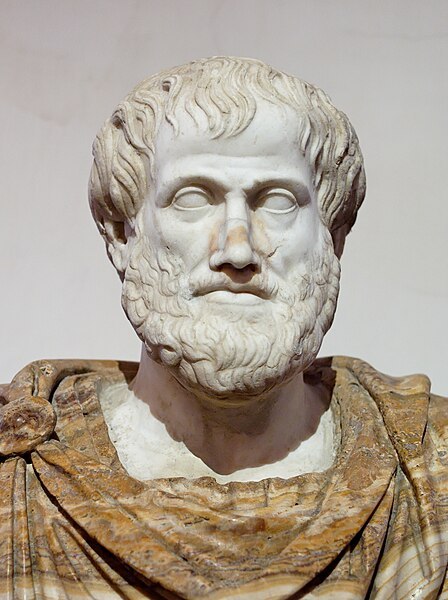
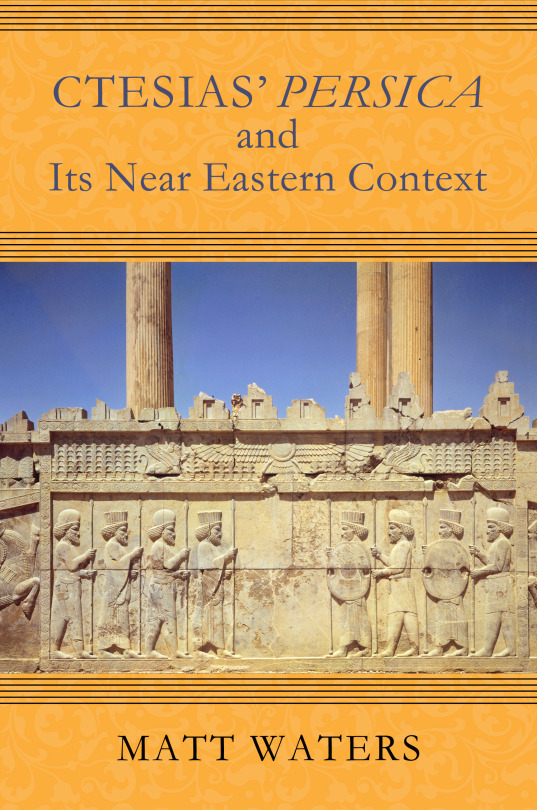
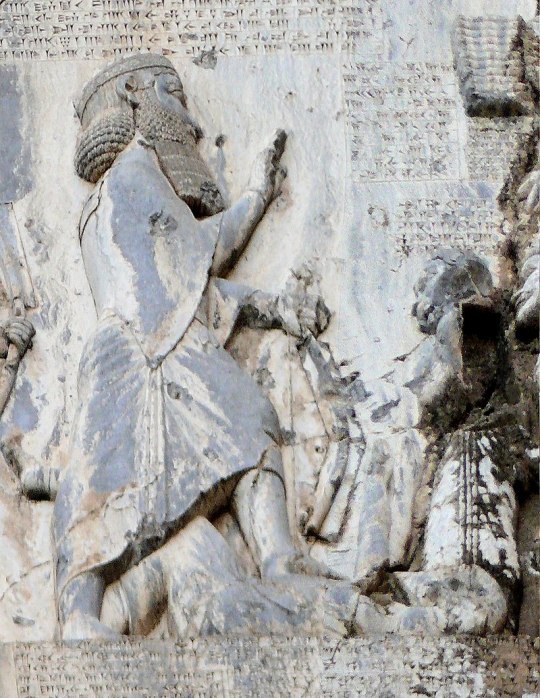
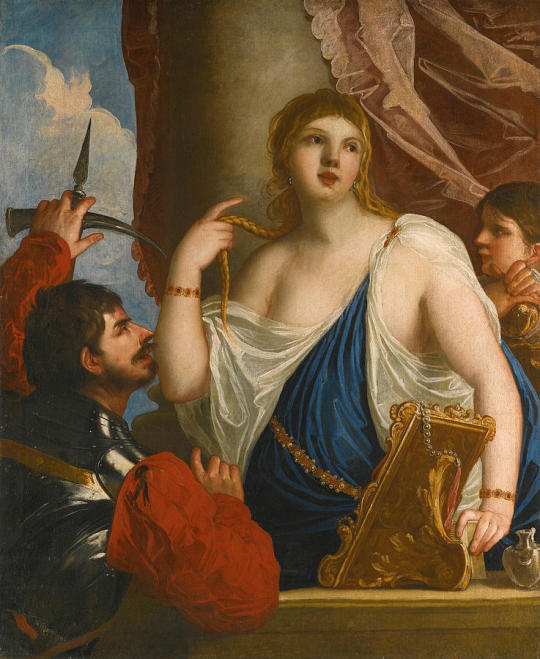
Contents
Introduction
I. A fictional concept: the origin of the fraud
II. A construct based on posterior textual sources
III. The deceitful presentation
IV. 5th century BCE texts found in 15th c. CE manuscripts do not make 'History'.
V. Abundant evidence of lies and deliberate distortions attested in the manuscript transmission
VI. Darius I the Great, the Behistun inscription, and Ctesias
VII. The historical Assyrian Queen Shammuramat and the fictional Queen Semiramis of the 'Ancient Greek sources'
VIII. The malignant intentions of the Benedictine liars: from the historical Darius I the Great to the fictional Semiramis
IX. The vicious distortions of the Benedictine liars: from Ctesias to Herodotus
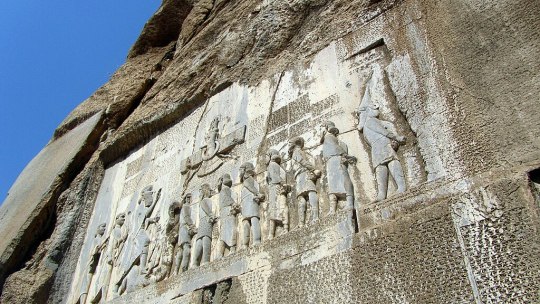
The Behistun inscription
Introduction
In the present article, I will offer a typical example of text falsification carried out by the Catholic monks, who did not 'copy and preserve' manuscripts of ancient Greek and Latin texts, as it has been mendaciously said by Western European and North American academics and lying scholars, but they purposefully falsified, distorted, concealed, destroyed and/or contrived numerous texts.
This enormous forgery took place in Western Europe between the 2nd half of the 8th century and the 1st half of the 15th century; the colonial era was launched exactly afterwards. For this reason, few manuscripts with Ancient Greek and Roman texts date before the 8th c.; in fact, most of them have been either distorted and replaced or hidden in the vast libraries still owned, controlled and administered that the anti-Christian Roman Catholic Church.
The purpose of this devious and evil effort was the fabrication of a fake narrative about the forged antiquity and the supposed importance of the Western Europeans according to the needs of world conquest, prevalence and preponderance of the pseudo-Christian Roman Catholic Church; this bogus-historical dogma, as direct opposition to and ultimate rejection of Orthodox Christianity, would be initially imposed as the 'scientific discipline of History' in Western Europe and subsequently projected onto the rest of the world by means of colonial invasion, indigenous identity destruction, moral integrity demolition, cultural heritage disintegration, educational subordination, economic exploitation, military subjugation, and socio-political domination.
In other words, the monastical scribes and copyists created an entirely fake Euro-centric past, which became the rotten foundation of Western Europe. This fallacy became known as Judeo-Christian world and Greco-Roman civilization. However, the decipherment of ancient languages (Egyptian hieroglyphic, Old Achaemenid Iranian, Assyrian-Babylonian, Sumerian, Hurrian, Hittite, Urartu, Ugaritic, etc) and the study of millions of original texts, which were not copies of earlier sources but contemporaneous to the events that they narrated, sounded the death knell of the era of history fabrication programs.
With the post-Soviet rise of the great continental powers (China, India, Russia, etc.), the economic-military-political-ideological-educational-academic-cultural tyranny of the Western World started being overthrown throughout the earlier colonized world. The historical forgery that the colonial rulers imposed collapsed, the falsehood of the Eurocentric dogma of World History started being revealed and rejected, and an overwhelming project of total de-Westernization appeared as a prerequisite for the liberation of the Mankind from the lies of the European Renaissance, the Western Humanities, the White Supremacism, the Western European colonialism and racism, as well as from the falsehood of numerous subsystems of the construct, such as Classicism, Hellenism, Orientalism, etc.
In our days, it is imperative for anti-colonial scholars to unveil the distortions applied to Ancient Greek and Latin texts by the medieval monks. Consequently, historians from all over the world have to work together in order to denounce and obliterate the Western fraud and the fake History of the Western Man, which consists in arbitrarily taking 14th c. CE manuscripts as authentic narratives of Ancient History.
I. A fictional concept: the origin of the fraud
Apparently, the present brief article cannot be an exhaustive presentation of the Western fraud, and of the historical forgery that the Western monks, manuscript copyists, collectors, academics and propagandists attempted to impose worldwide through colonial conquests, massacres and tyrannies. However, I can still enumerate the major founding myths of the Western World.
Two thematic circles of historical distortions and fraudulent claims made by the Western academia revolve around the following two entirely fabricated entities, which have conventionally but erroneously been called
a) "the Greco-Roman world" and
b) "Biblical Israel" and "Judeo-Christian civilization".
These ahistorical entities never existed. The original concept of those notions is purely fictional, and it therefore remains always unquestioned in the fraudulent Western universities. In this regard, the sources that the Western academics evoke to support their claims are posterior, untrustworthy, forged and therefore worthless.
At times, some of those texts represent merely ancient authors' misperceptions of earlier texts and authors; however, more often, the ancient texts have been tampered with. On other occasions, ancient texts that refute the lies of other historical sources are hidden from the general public and conventionally discussed among the Western academic accomplices.
II. A construct based on posterior textual sources
The entire construct hinges on the deceitful presentation of several types of material forged, collected, concealed, interpreted, contextualized, narrated, repeatedly but intentionally discussed, supposedly questioned, and selectively popularized; this was due to the fact that the said material was incessantly utilized for the colonial needs and targets of the Western European powers (England, France, Holland, Spain, Portugal, and more recently the US). In fact, the Western World's fake History was created as the ultimate support of all colonial claims.
This process happened within a system in which posterior textual sources (preserved in medieval manuscripts) have occupied the central position, whereas the ancient epigraphic material, which was contemporaneous to the historical events under study, has been deliberately disregarded.
All later discovered data and pieces of information were either adjusted to the construct or methodically hidden; this is how the original concept, pathetically believed almost as a religious dogma, remained totally unchallenged down to our days.
III. The deceitful presentation
The quintessence of the deceitful presentation involves a vicious trick; people (pupils and students, but also scholars and intellectuals, as well as the general public) are taught and made accustomed to care mainly about the absolutely insignificant dates of birth and death of historical persons (authors, rulers, etc.), and not about the dates of the manuscripts in which these individuals are mentioned as supposed authors; this situation turns readers, students and scholars into pathetic idiots.
Subsequently, we cannot seriously afford to describe Herodotus as a 5th c. BCE writer, because there is no manuscript with texts attributed to him, dating before the 10th c. CE. In addition, if we take into account the enormous number of other ancient authors decrying, denigrating and rejecting Herodotus' absurdities and malignancy, we have to permanently and irrevocably obliterate Herodotus from the History of Mankind and consider his false, paranoid and racist texts as a double Crime against the Mankind:
first, with respect to the original narrative (to which we don't have access as it was distorted by medieval monastical scribes and copyists) because the author attempted to disparage the superior Iranian civilization and the majestic Achaemenid universalist empire, while undeservedly praising the South Balkan barbarians, and
second, as regards the currently available text, which was forged as per the discriminatory intentions of the monks who altered and distorted it in their effort to fabricate the fake, modern divide (or dichotomy) East-West, and to offer a shred of historicity to it.
IV. 5th century BCE texts found in 15th c. CE manuscripts do not make 'History'.
People get therefore addicted to considering as a true and original 'work' (of an ancient author) the manuscript (or manuscripts) in which the specific treatise, essay or book was copied perhaps 10 or 15 centuries after the author composed it. Due to a long chain of intermediaries (namely library copyists, librarians, scholars, monks, collectors, purchasers and/or statesmen), the transmitted text may have been partly or totally changed.
There is absolutely no guarantee as regards the honesty, the good intentions, the unbiased attitude, and the benevolent character of the perhaps 5, 10, 20 or 50 persons who -living in different eras and without knowing one another- may have constituted the chain of (unknown to us) intermediaries between the hand of the author and that of the last copyist whose manuscript was preserved down to our times.
Example: very little matters today whether the ancient author Diodorus Siculus or Siceliotes (西西里的狄奧多羅斯) actually lived in the 1st c. BCE or in the 3rd c. CE; quite contrarily, what is important for history-writing is the fact that the earliest known manuscript of his famous 'Bibliotheca Historica' (世界史) dates back to the 10th c. CE.
Consequently, the first piece of information that should be stated after the name of any 'ancient' Anatolian, Macedonian, Thracian, Greek, Roman and other author is the date of the earliest extant manuscript of his works.
V. Abundant evidence of lies and deliberate distortions attested in the manuscript transmission
An extraordinarily high number of original sources excavated in Mesopotamia, Egypt, Anatolia, Canaan, Iran and elsewhere, and subsequently deciphered, can be dated with accuracy; example: the Annals of great Assyrian emperor Tiglath-pileser III (745-727 BCE) were written during his reign. They are contemporaneous and therefore original.
However, in striking contrast to them, almost all the manuscripts with the works of ancient Greek and Roman authors whose texts have formed the backbone of the fraudulent historical dogma of the Western academia are not contemporaneous but posterior by, at times, 1500 or 2000 years.
Even worse, numerous ancient Greek authors' texts were not preserved through a manuscript tradition at all; they were saved as references in posterior authors' works. This concerns, for instance, Ctesias (克特西亞斯), an Ancient Carian (Anatolian) physician and erudite scholar, who lived and worked in the court of the Achaemenid Iranian emperor Artaxerxes II in the 5th c. BCE.
Later, willing to offer potential guidebooks to Iran and India for the use of various peripheral peoples and tribes of the Balkan region, Ctesias elaborated in Ancient Ionian (愛奧尼亞希臘語) two treatises to describe the state of things in Iran and in India. To the Western academic bibliography, his works are known (in Latin) as 'Persica' and 'Indica'.
These texts were not saved integrally in manuscripts copied for the purpose of preserving Ctesias' works, but they were preserved in Diodorus Siculus' 'Bibliotheca Historica'. Although he is not known through authentic and contemporaneous Iranian sources, we can deduce that Ctesias certainly spoke fluently the official language of the Empire and read Old Achaemenid cuneiform. Eventually, he may have also studied and learned Babylonian and Elamite cuneiform, namely two ancient Mesopotamian cuneiform languages and writings the use of which was maintained by Iranian scribes.
Apparently, Ctesias had a firsthand insight, as he lived for many years in Parsa (Persepolis), the capital of the Achaemenid Empire and he also traveled extensively along with the Iranian emperor. But, unfortunately, the following ordeal was produced.
VI. Darius I the Great, the Behistun inscription, and Ctesias
One century before Ctesias served Artaxerxes II, the empire of Iran was saved by Darius I the Great (大流士一世; reign: 522-486), who overthrew a usurper, namely the Mithraic (密特拉教祭司) magus Gaumata (高墨达), and by so doing, preserved on the throne a dynasty of faithful Zoroastrian (瑣羅亞斯德教徒) monarchs.
To commemorate his great victory and the consolidation of the his dynasty, Darius I the Great had an enormous rock relief and a monumental inscription (貝希斯敦銘文) engraved on the rocks of Mount Behistun (貝希斯頓山), at a distance of 150 km west of Hamadan (哈马丹; Ekbatana/埃克巴坦那) in Western Iran (15 m high by 25 m wide and 100 m up the cliff). As it can be easily understood, these events occurred after the assassination of Cambyses, at the very beginning of Darius I the Great's reign.
It goes without saying that the successors of Darius I the Great and the imperial Iranian administration knew perfectly well the historical details and were fully aware of the imperial inscription that immortalized the event, which had obviously become the cornerstone of the imperial education.
VII. The historical Assyrian Queen Shammuramat and the fictional Queen Semiramis of the 'Ancient Greek sources'
However, one century later, when Ctesias lived in Iran, served the Iranian Emperor, and spoke Old Achaemenid Iranian (and if not, he was surrounded by the Empire's top interpreters and advisers), something disastrously odd 'happened'.
According to Diodorus Siculus, who explicitly stated that he extensively quoted from Ctesias' text (Bibliotheca Historica, II 13), the imperial Carian physician and author appears to have attributed the Behistun inscription and the rock reliefs to none else than the Assyrian Queen Shammuramat (薩穆-拉瑪特), who was the queen consort of the Assyrian Emperor Shamshi Adad V (沙姆什·阿達德五世; reign: 824-811) and co-regent (811-805) during the first years of reign of her son Adad Nirari III (阿达德尼拉里三世; reign: 811-783)!
Furthermore, in the 'Ancient Greek' text of Diodorus Siculus, the monumental inscription was said to be written in Assyrian cuneiform (Συρίοις γράμμασιν)! Even worse, in the same text (as preserved today), it was also stated that, in the rock relief, there was also a representation of the Assyrian queen!
Ctesias' text, as preserved by Diodorus Siculus, is truly abundant in information, but it is historically impossible and therefore entirely forged. Due to this and many other texts, an enormous chasm was unnecessarily formed between
a) the historical queen Shammuramat of Assyria, whose historicity is firmly undeniable, due to the existence of several contemporaneous cuneiform sources excavated in Assyria, and subsequently deciphered and published,
and
b) the purely fictional Assyrian queen Semiramis (沙米拉姆) of the posterior Ancient Greek textual sources that were supposedly 'preserved' (but in reality deliberately distorted and forged) in the Benedictine manuscripts of Western Europe's monasteries.
However, if we examine closely the facts, we will surely understand what truly occurred in this case; then, we will be able to fathom how the fake History of the Western world was fabricated.
The Behistun inscription is trilingual, as it was written in Old Achaemenid Iranian (the earliest form of written Iranian languages), Babylonian, and Elamite; this was a very common practice during the Achaemenid times (550-330 BCE). The main figure of the associated rock relief is Darius I the Great, evidently the representation of a male royal.
One way or another, with respect to the Behistun inscription and rock relief, Ctesias certainly knew everything that we know today after the successive decipherments of the Old Achaemenid, Babylonian and Elamite cuneiform writings, or perhaps even more, due to the then extant oral tradition.
VIII. The malignant intentions of the Benedictine liars: from the historical Darius I the Great to the fictional Semiramis
The Behistun inscription is not Assyrian; the representation is not that of female royal; and the monument is totally unrelated to Shammuramat, who had lived 300 years before Darius I the Great and 400 years before Artaxerxes II's physician Ctesias. More importantly, by that time, the Assyrian Empire did not occupy the lands surrounding Behistun. Accompanied by Iranian imperial officers and his associates, Ctesias certainly learned all the details of the monumental inscription that we can now read in articles, courses, lectures, books and encyclopedias.
The narrative was a triumph for Darius I the Great and a spectacular rebuttal of the vicious Mithraic Magi who had supported the defeated evil sorcerer and villain Gaumata. Apparently, writing a guidebook for Iran to help marginal people of the Empire's Balkan periphery, Ctesias did not have any reason to say lies. Moreover, we don't have any reason to believe that Diodorus Siculus needed to distort the truth to that extent, when copying and thus preserving Ctesias' masterpiece for the posterity.
However, the transmission of the details about the Behistun inscription embarrassed the Benedictine copyists who wanted to denigrate Darius I the Great and to portray his great empire in a most derogatory manner. They had already proceeded in this manner, distorting other manuscripts, forging texts, and fabricating their pseudo-historical narratives at will.
That is why Ctesias' pertinent text, which had certainly been preserved in its original form within Diodorus Siculus' Bibliotheca Historica, was intentionally distorted by the Benedictine 'Holy Inquisition of Libraries', which fabricated the myths of today's Western world some time after the middle of the 8th c. CE. To be accurate, Ctesias' historical description was entirely replaced by a fictional and historically nonsensical account.
The unbelievable lies -invented and included in Diodorus Siculus' quotations from Ctesias- risked making of the fictional queen Semiramis a world ruler! Whereas the Assyrian Empire at the end of the 9th c. BCE did not control even the western half of today's Iranian territory, the unequivocally mythicized Semiramis had supposedly sent her armies up to India where those fictitious Assyrian soldiers were trampled by the elephants. This worthless narrative that replaced Ctesias' original text may very well have been invented as a 'historical' excuse for Alexander the Great's failure to advance deep inside India.
IX. The vicious distortions of the Benedictine liars: from Ctesias to Herodotus
But if the fictional Semiramis' Indian campaign is entirely false, so are then the preposterous narratives of Herodotus about Darius I the Great's and Xerxes I the Great's campaigns in the insignificant and barbarian circumference of South Balkans. These texts involved evil purposes, heinous anti-Iranian biases, fictional battles, racist discourses, vicious lies, incredibly large number of the Iranian armies, and absurdly high number of Iranian casualties.
The mendacious but idiotic Benedictine monks, who wrote those slander tales did not apparently expect that, sometime in the future, excavations would bring to light splendid Iranian antiquities, original cuneiform documentation, and trustworthy contemporaneous historical sources, whereas a systematic effort of decipherment would offer to people all over the world direct access to historical texts written in dead languages, thus irrevocably canceling Herodotus' nonsensical report and, even more importantly, the later distortions that the Benedictine monks made on their worthless manuscripts.
In any case, had those fictional campaigns against 'Greece' had a shred of truth to them, they would have certainly been documented one way or another in various Old Achaemenid, Babylonian, Elamite, Imperial Aramaic, Egyptian hieroglyphic or other sources; but they were not.
Even worse, the meaningless and ludicrous battles of Marathon, Thermopylae, Salamis, and their likes would have been commemorated by the Seleucids, the Ptolemies, and the Attalids all the way down to the Romans and the Eastern Romans. But we know quite well that the nonexistent, fictional past of the so-called Ancient Greek world was absolutely irrelevant to them: precisely because it had not yet been fabricated.
===================
Aristotle as Historical Forgery, the Western World’s Fake History & Rotten Foundations, and Prof. Jin Canrong’s Astute Comments
Contents
I. Aristotle: a Major Founding Myth of the Western World
II. When, where and by whom was the Myth of Aristotle fabricated?
III. The Myth of Aristotle and its first Byproducts: Scholasticism, East-West Schism, the Crusades & the Sack of Constantinople (1204)
IV. Aristotelization: First Stage of the Westernization and the Colonization of the World
V. Aristotelization as Foundation of all the Western Forgeries: the so-called Judeo-Christian Heritage and the Fraud of Greco-Roman Civilization
VI. The Modern Western World as Disruption of History
VII. The Myth of Aristotle and the Monstrosity of Western Colonialism
======================
Download the article in PDF:
#Ctesias#Diodorus Siculus#Behistun Inscription#iran#Achaemenid#Behistun#Bisotun#Darius I the Great#Gaumata#Mithraism#Zoroastrianism#Ahura Mazda#Mithra#Xerxes I#Herodotus#Ancient Greeks#manuscript transmission#Shamshi Adad V#Adad Nirari III#Shammuramat#Semiramis#Benedictines#Renaissance#Classicism#Classics#Orientalism#Hellenism
1 note
·
View note
Text
Πνευματικότητα, Θρησκείες, Θεολογίες, Ιδεολογίες, Αποδοχή μιας άλλης Θρησκείας, Προσηλυτισμός και Πολυπολιτισμικότητα
Περιεχόμενα
Α. Πνευματικότητα, Θρησκείες, Θεολογίες και Ιδεολογίες
Β. Αποδοχή μιας άλλης θρησκείας και δράση προσηλύτων
Γ. Εγκλήματα προσηλυτιστών
Δ. Αλλαγή θρησκείας, προσηλυτισμός και πολυπολιτισμικότητα
Ε. Δεν υπάρχει το Ισλάμ ως θρησκεία χωρίς τις ιστορικές ισλαμικές επιστήμες
Επίλογος

Α. Πνευματικότητα, Θρησκείες, Θεολογίες και Ιδεολογίες
Οι δρόμοι του Ανθρώπου προς τον Θεό είναι άπειροι. Το ίδιο άτομο μπορεί να διέλθει πολλούς διαφορετικούς δρόμους στην πορεία του προς τον Θεό. Οι γνωστές ιστορικές θρησκείες αποτελούν -στην αρχή τους- προσπάθειες ένταξης της κοινωνίας σε δρόμους που οδηγούν στον Θεό. Αλλά πολύ συχνά οι πίστεις αλλοιώθηκαν, τα κηρύγματα παραχαράχθηκαν, και το αρχικό νόημα των θρησκειών εξαφανίστηκε. Αυτό μάλιστα φαίνεται στον πολιτισμό των εθνών ο οποίος αποτελεί την κοίτη από όπου προέρχονται οι θρησκείες, ενώ παράλληλα διαμορφώνεται και από αυτές, καθώς και από την εξέλιξη ή φθορά τους.
Και ενώ η πορεία προς τον Θεό αποτελεί αυτό το οποίο καλούμε πνευματικότητα (spirituality), η απόπειρα ερμηνείας της θρησκείας δημιουργεί μία όλως διαφορετική οντότητα, την θεολογία. Συχνά-πυκνά, η θεολογία αλλοιώνει την θρησκεία, την οποία υποτίθεται ότι ερμηνεύει, και ακόμη συχνώτερα στρέφεται εναντίον όλων όσοι αφοσιώνονται στην πνευματικότητα. Αυτό συμβαίνει επειδή η πνευματικότητα δεν είναι κοινωνικό φαινόμενο παρά μόνον στον βαθμό της ύπαρξης ενός οργανωμένου κύκλου πιστών αφοσιωμένων στην μύηση και στην εξάσκηση πάνω στους δρόμους της ανθρώπινης πορείας προς τον Θεό. Και ενώ η θρησκεία επιχειρεί να καταστήσει την πνευματικότητα σεβαστή, ελκυστική, αποδεκτή, προσιτή και εφικτή για όλους, η θεολογία κατά κανόνα σκοτώνει την πενυματικότητα.
Αυτό συμβαίνει επειδή η θεολογία, ως απόλυτα κοινωνικό φαινόμενο εξαιτίας της λειτουργικότητάς της να εξηγήσει την θρησκεία, συνιστά κατά κανόνα έκφραση ανθρώπινου συλλογισμού, άχρηστου στοχασμού, αχρείαστης σκέψης, υλι(στι)κής πρόσληψης, λαθεμένης κατανόησης (της θρησκείας), άγονης επιχειρηματολογίας, και ντε φάκτο προκαταδικασμένης ορθολογιστικής προσέγγισης. Όλα αυτά στρέφονται κατά της πνευματικότητας.
Ο Θεός δεν προσεγγίζεται ορθολογικά, επειδή ο ορθολογισμός, ή απλά η ανθρώπινη λογική, είναι τμήμα της Πτώσης του Ανθρώπου, και συνεπώς ο αρχικός άνθρωπος ήταν ασυγκρίτως υπεράνω των αχρήστων στο Ψυχικό Σύμπαν εννοιών, λειτουργιών και συνθηκών της 'γλώσσας', της 'γραφής', της 'σκέψης', της 'λογικής', καθώς και της κοινωνίας'. Η δε ψυχική κοινότητα είναι ολότελα διαφορετική της γνωστής υλικής.
Ναι, βεβαίως και υπήρξαν ιερά βιβλία σε πολλές θρησκείες, αλλά σύμφωνα με όλες τις θρησκείες δεν υπήρξε κανένα ιερό βιβλίο πριν από την Πτώση του Ανθρώπου. Τα ιερά βιβλία, όπως και τα κηρύγματα των Προφητών, είναι κλήσεις για επαναφορά στον αρχικό Κώδικα της Δημιουργίας, ο οποίος ήταν έμφυτος στον Αδάμ: αυτόν ακριβώς αποκαλούμε 'Ηθική'. Για κάθε άνθρωπο, δεν υπάρχει Ζωή χωρίς Ηθική. Αν πολλοί νομίζουν ότι μπορούν να υπάρχουν χωρίς Ηθική, αυτή και μόνον η εικασία τους καθιστά ζωντανούς-νεκρούς – ζόμπι.
Αργά αλλά σταθερά, οι θεολογίες -ως παρασιτικά φυτά- κουκούλωσαν τις θρησκείες και έπνιξαν την πνευματικότητα. Ένα τέτοιο παράδειγμα στον χώρο του Ισλάμ είναι η απαγόρευση του τάγματος των Μπεκτασήδων στην δεκαετία του 1820 κατόπιν της επιμονής των περί τον σουλτάνο θεολόγων. Καθώς αυτό το βαθειά αντι-ισλαμικό μέτρο υλοποιήθηκε παράλληλα με την ακόμη πιο καταστροφική απόφαση σχετικά με την κατάργηση του στρατιωτικού σώματος των Γενιτσάρων, η καταρρέουσα από τους κρετίνους ιμάμηδες και τους ηλίθιους σεϊχουλισλάμηδες Οθωμανική Αυτοκρατορία οδηγείτο με μαθηματική ακρίβεια προς εξαφάνισιν. Και όντως αυτό έτσι συνέβηκε.
Ακόμη χειρότερα, η άνοδος στην εξουσία εγκληματικών σατανιστικών οργανώσεων στην Δυτική Ευρώπη του 15ου αιώνα, ο εκ μέρους τους έλεγχος της εκεί εξουσίας, και στην συνέχεια, η αποικιοκρατική κατάκτηση του κόσμου απετέλεσαν ένα συθέμελο κτύπημα εναντίον όλων των πολιτισμών, των αυτοκρατοριών, των θρησκειών και των κατά τόπους μυστικών οργανώσεων που συγκέντρωναν ακόμη σημαντικό αριθμό μυστών και ψυχικών ασκητών. Η δυτική αποικιοκρατία επέβαλε σχεδόν παντού την σατανική πνευματικότητα, τον θρησκευτικό προσηλυτισμό και τις συνεπακόλουθες διαιρέσεις, καθώς και τοπικές εξουσίες που, όντας δουλικές προς τους Δυτικούς, εργάζονταν για την καταστροφή των χωρών και των ομοεθνών τους.
Καθώς στην Δυτική Ευρώπη, άθλιες και άχρηστες θεωρίες, διεστραμμένες σκέψεις, ανοησίες ταμπελισμένες ως "φιλοσοφίες", και παρανοϊκά θεωρητικά συστήματα ετοιμάζονταν και διαδίδονταν με παγκοσμίως καταστρεπτικό σκοπό, οι ακαδημαϊκές ελίτ των αποικιοκρατών με σκοπό την επιβολή τους έδωσαν μεγάλη σημασία στο να μετατρέψουν συστηματικά τα κατά τόπους χείριστα θεολογικά συστήματα σε απλά ιδεολογήματα ώστε να τραβήξουν όλους τους εκεί πιστούς ακόμη πιο μακριά από την πνευματικότητα, την ηθική, την θρησκεία, την λαϊκή θρησκεία, την παράδοση, και την όλη παιδεία τους. Έτσι, βαθμιαία σβύστηκε η μη σατανική πνευματικότητα και ξέφτισαν όλες οι θρησκείες – με μικρή ίσως εξαίρεση εκείνες των πλέον μικρών και απόμακρων εθνών των οποίων το δύσβατο της γης χρησίμευσε ως ασπίδα κατά της αποικιοκρατίας, των άθλιων δυτικών ιδεολογημάτων, και του απάνθρωπου, διεστραμμένου μοντερνισμού.
Οπότε, σήμερα (ήδη από τα τέλη του 18ου, τις αρχές του 19ου αιώνα, και τις απαρχές της αγγλο-γαλλικής αποικιοκρατίας), όποιος αποδέχεται ή προσχωρεί σε μία άλλη θρησκεία, ουσιαστικά πιστεύει ένα ιδεολόγημα του οποίου το σημείο αναφοράς είναι η θρησκεία, την οποία ο νεοφώτιστος νομίζει ότι ευαγγελίζεται. Το αφήγημα της θρησκείας μπορεί να παραμένει το ίδιο, η θεολογική προσέγγιση μπορεί να είναι η ίδια, αλλά το όλο σύνολο έχει ιδεολογικοποιηθεί, κάτι που αυτόματα σημαίνει 'δυτικοποιηθεί'. Έτσι, το πραγματικό νόημα και η αληθινή αίσθηση της υποκείμενης θρησκείας έχουν χαθεί ανεπιστρεπτί. Μόνον όποιος ακολουθήσει τον δύσκολο δρόμο της ανασύστασης της θρησκείας στην οποία έχει προσχωρήσει μπορεί να αντιληφθεί πόσο διαφορετικός ήταν ένας Ιουδαίος των χρόνων του Μαϊμονίδη (1138-1204), ένας χριστιανός της εποχής του Μιχαήλ Ψελλού (1018-1078), και ένας μουσουλμάνος του καιρού του Νεζαμί Γκαντζεβί (1141-1209) από τους συγχρόνους ομολόγους τους.
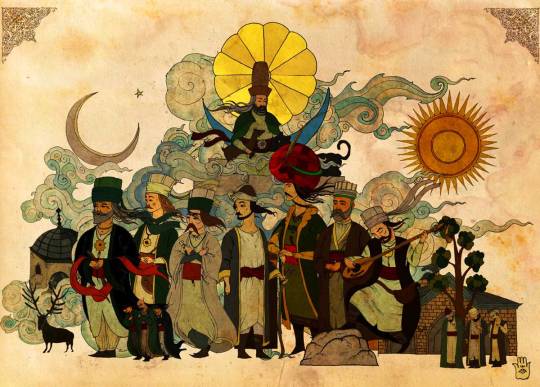
Β. Αποδοχή μιας άλλης θρησκείας και δράση προσηλύτων
Βεβαίως, καμμία κοινωνική κατάσταση δεν προκαθορίζει αναγκαστικά την πορεία ενός ανθρώπου προς τον Θεό. Υπάρχουν πολλοί που επηρεάζονται από κοινωνικές περιστάσεις, οπότε ψυχικώς είναι νεκροί, και υπάρχουν πολλοί που ακούνε το κάλεσμα για την μόνη υπαρκτή πραγματικότητα: το ψυχικό σύμπαν. Ο τρόπος με τον οποίο κάποιος αλλάζει θρήσκευμα ποικίλει. Είναι προτιμώτερο να δεχθούμε ότι ο κάθε άνθρωπος αποτελεί μία ξεχωριστή και μεμονωμένη περίσταση, παρά να αποπειραθούμε να κατηγοριοποιήσουμε σαν να ήμασταν θεράποντες της ολότελα ανύπαρκτης ψευδο-επιστήμης της 'κοινωνιολογίας'.
Έτσι, για να δώσω απλώς μερικά παραδείγματα, μπορεί κάποιος να ακούσει ένα εσωτερικό (ψυχικό) κάλεσμα και να βρει τις αρχές και τα διδάγματα μιας θρησκείας εγγύτερα στην προσωπικότητά του, απορρίπτοντας έτσι την πίστη την οποία πιο πριν επρέσβευε, και μπορεί κάποιος άλλος να απορρίψει την θρησκεία του για ιστορικούς λόγους, αντιλαμβανόμενος ότι αποτελεί αλλοίωση ενός αρχικώς σωστού κηρύγματος, και αργότερα να αποδεχθεί μίαν άλλη, επειδή την ερμηνεύει ως την ορθή συνέχεια ενός διαχρονικού κηρύγματος αφοσίωσης στον Θεό.
Επίσης ποικίλει ιδιαίτερα και η δράση δύο νεοφώτιστων σε μία θρησκεία άλλη από εκείνη των προγόνων τους. Κάποιος μπορεί να θελήσει να δει την νέα θρησκεία του στις πραγματικές διαστάσεις της, δηλαδή ως ένα ιστορικό φαινόμενο, το οποίο συμπεριλαμβάνει όχι μόνον την σχετική πνευματικότητα, μυστικισμό, λατρεία, ηθική, αρχές και αξίες, αλλά και την λαϊκή θρησκεία, τα γράμματα, τις τέχνες, τις επιστήμες, την αρχιτεκτονική, όπως επίσης και το σχετικό φιλοσοφικό σύστημα συμπεριφοράς, και έτσι να καταλάβει την ιστορική πραγματικότητα της εν λόγω θρησκείας ασυγκρίτως καλλίτερα ακόμη και από τους προύχοντες και τους αξιωματούχους της θρησκείας αυτής. Κάποιος άλλος μπορεί να αρκεστεί στην απλή ανάγνωση, μελέτη και αποδοχή των ιερών κειμένων της νέας θρησκείας του, να αποδεχθεί μία από τις αρκετές υπαρκτές θεολογικές ερμηνείες τους, και να θεωρήσει υποχρέωσή του να καταστήσει την νέα θρησκεία του γνωστή σε πολλούς άλλους που δεν την γνωρίζουν.
Μία θρησκεία δεν είναι θρησκεία, αν δεν διεκδικήσει την αποκλειστικότητα στην σωτηρία για όλους τους ανθρώπους, αλλά ποτέ ένα αρχικό κήρυγμα ή σύστημα ψυχικών-ηθικών αξιών, από το οποίο έχει προκύψει μία θρησκεία, δεν διεκδίκησε κάτι τέτοιο ειμή μόνον στις αρχικές κοινωνίες μέχρι τον Κατακλυσμό. Αλλά εκεί επρόκειτο για μία γενικευμένη αντιπαράθεση ανάμεσα στο Καλό και στο Κακό. Ούτε ο Μωϋσής, ούτε ο Ιωνάς, ούτε ο Ιησούς, ούτε ο Μωάμεθ μπορούσαν άλλωστε να διεκδικήσουν την αποκλειστικότητα, δεδομένου ότι όλοι τους εμφαντικά ανάγονταν και συχνά αναφέρονταν σε πρότερα κηρύγματα και μορφές μονοθεϊστικής πίστης. Ασφαλώς και απεσαφήνισαν ότι υπάρχει μία διαρκής αποκλειστικότητα, αλλά αυτή αφορά τον ορθό δρόμο προς τον Θεό. Ο δρόμος αυτός όμως παρέχει απέραντη ποικιλία πορειών...
Τίποτα δεν αποδεικνύει την αλήθεια του πρότερου ισχυρισμού μου περί μετατροπής όλων των θρησκειών σε ιδεολόγίες μέσα στα πλαίσια των συγχρόνων κοινωνιών (οι οποίες είναι σχεδόν όλες παράγωγα αποικιοκρατίας) καλλίτερα από το γεγονός ότι σήμερα πολλοί άνθρωποι, οι οποίοι αποδέχονται μία άλλη 'θρησκεία' (διάβαζε: 'ιδεολογία'), επιδιώκουν συχνά να προσηλυτίσουν και άλλους στην θρησκεία αυτή. Αυτό είναι συμπεριφορά οπαδού ιδεολογίας και μάλιστα πολιτικής αλλά όχι πιστού θρησκείας.

Γ. Εγκλήματα προσηλυτιστών
Ως λέξη ο 'προσηλυτισμός' δεν έχει παντού και πάντοτε το ίδιο νόημα. Προσήλυτος δεν είναι ο 'προσηλυτισμένος' αλλά ο νεοφώτιστος, δηλαδή ο προσ-ερχόμενος (από το 'έρχομαι' στον παρακείμενο: 'ελήλυθα') σε μία θρησκεία. Κατά κανόνα, στα δυτικά κράτη, ο προσηλυτισμός, δηλαδή η εκ μέρους ενός πιστού προσέλκυση ενός άλλου ατόμου σε μία θρησκεία διαφορετική της δικής του, απαγορεύεται. Με δεδομένο ότι οι σύγχρονες δυτικές κοινωνίες και κράτη είναι άθλιοι εσμοί ψεύδους, υποκρισίας και διαστροφής, μπορούμε εύκολα να καταλάβουμε ότι αποικιοκράτες όπως οι Άγγλοι, οι Γάλλοι και οι Αμερικανοί απαγορεύουν στους άλλους να κάνουν ό,τι συνεχώς και αδιαλείπτως οι ίδιοι επιχειρούν. Η ιστορία των δήθεν ιεραποστολών είναι ένα έγκλημα εναντίον πολλών αφρικανικών, κυρίως αν και όχι αποκλειστικώς, εθνών.
Πολύ λίγοι υποψιάζονται το έγκλημα το οποίο επιτελείται με τις σατανικές ιεραποστολές των Προτεσταντών (κάθε φυράματος) και των Καθολικών στην Αφρική και αλλού: ο δήθεν εκχριστιανισμός πολλών αφρικανικών εθνών δεν ήταν ποτέ αληθινός. Στην πραγματικότητα, επρόκειτο για ένα άθλιο εκδυτικισμό και με δεδομένο ότι οι ξεπεσμένες, σάπιες σημερινές δυτικές κοινωνίες είναι ολοσχερώς αντίχριστες και απόλυτα αντι-χριστιανικές, ο ψευτο-εκχριστανισμός των Αφρικανών είναι μία μεθοδευμένη πνευματική γενοκτονία. Πολύ πιο κοντά στον Θεό (όπως και αν Τον εννοούσε και Τον επίστευε) θα ήταν μία αφρικανή κοπέλλα στο χωριό ή στον καταυλισμό της, όπου θα παντρευόταν και θα γινόταν μία αξιοσέβαστη μητέρα, παρά 'εκχριστιανισμένη', εκδυτικισμένη, και συνεπώς εκπορνευμένη να ζει μέσα στο αίσχος των προγαμιαίων και εξωγαμιαίων σχέσεων, καθώς και όλων των οικτρώς απανθρώπων ανωμαλιών, δυσλειτουργιών και μολυσματικών ασθενειών της Δύσης.
Πολύ λίγοι υποψιάζονται το έγκλημα το οποίο επιτελέστηκε με τις σατανικές ιεραποστολές των Προτεσταντών (κάθε φυράματος) και των Καθολικών στην Ασία εις βάρος πολλών ανατολικών χριστιανών και κυρίως των Αραμαίων Μονοφυσιτών (ή Μιαφυσιτών, ή Ιακωβιτών), των Αραμαίων Νεστοριανών, των Αρμενίων, των Γεωργιανών, και των Αραμαίων του Μαλαμπάρ (στην Δυτική Ινδία), όπως επίσης και στην Αφρική εναντίον των Κοπτών της Αιγύπτου.
Η αντίχριστη αγγλοσαξωνική χολέρα μισούσε θανάσιμα τον Νεστοριανισμό, επειδή ήταν η πιο αυθεντική μορφή Χριστιανωσύνης η οποία είχε επιβιώσει. Όχι μόνον έστειλαν σατανο-ιεραποστόλους στους τόπους όπου κατοικούσαν πολλές κοινότητες Νεστοριανών στην Οθωμανική Αυτοκρατορία και στο Ιράν (ως αντίβαρο των εκεί ήδη αφιγμένων Καθολικών σατανο-ιεραποστόλων) αλλά ακόμη ξεσήκωσαν και τους πρώιμους Ουαχαμπιστές ψεευτο-μουσουλμάνους της αραβικής ερήμου, κατά τα χρόνια της εξέγερσής τους εναντίον των Οθωμανών (στα τέλη του 18ου και στις αρχές του 19ου αιώνα), προσκαλώντας τους (από τις εγκαταστάσεις-αποικίες τους στην Ινδία) να επιτεθούν ενάντια στους ιστορικούς Νεστοριανούς της Σοκότρα στον Ινδικό Ωκεανό και να τους εξισλαμίσουν. Αυτό ήταν ένα εξίσου αντιχριστιανικό και αντι-ισλαμικό έργο των βρωμερών σατανόψυχων Ουαχαμπιστών.
Η διάδοση μίας θρησκείας δεν μπορεί να γίνεται με στρατιωτικά μέτρα και με σκοτωμούς, όπως κατ' έξοχήν έγινε η επιβολή του ρωμαϊκού χριστιανισμού τον 4ο και 5ο αιώνα, ή ακόμη χειρότερα η βίαιη επικράτηση του σατανικού καθολικισμού στο Μεξικό, στο Περού και σε όλους τους χώρους που κατακτήθηκαν από τους άθλιους, αντίχριστους κονκισταδόρες. Όσοι δυτικοί προπαγανδιστές μιλούν καταδικαστικά εναντίον του Ισλάμ, ως θρησκείας διαδεδομένης με πολεμικές κατακτήσεις,
- πρώτον, αγνοούν εξεπίτηδες ότι πολλά έθνη και χώρες δέχθηκαν το Ισλάμ χωρίς πόλεμο (Υεμένη, Αβησσυνία, Σομαλία, Ανατολική Αφρική, Τουρανοί του Βόλγα, της Ανατολικής Ευρώπης, της Κεντρικής Ασίας, και της Σιβηρίας, κα),
- δεύτερον, συγκαλύπτουν το καθοριστικό γεγονός ότι οι πραγματικοί μουσουλμάνοι οι οποίοι περί τον Αλί αποτελούσαν την μόνη παρακαταθήκη του κηρύγματος του Μωάμεθ, δεν συμμετείχαν σε κανένα κατακτητικό ��όλεμο, ούτε και νομιμοποίησαν κανένα (στα χρόνια που ο Αλί ιμπν Αμπί Τάλεμπ ήταν χαλίφης έπαυσε κάθε πόλεμος εναντίον 'αλλοθρήσκων'),
- τρίτον, αποσιωπούν τις εκατόμβες των θυμάτων των Ρωμαίων στρατιωτών εναντίον όλων των αρνητών της Χριστιανωσύνης και όλων των δήθεν 'αιρετικών',
- τέταρτον, λησμονούν τα εκατομμύρια των θυμάτων της αποικιοκρατίας,
- πέμπτον, ξεχνούν την υποδειγματική ειρηνική διάδοση του Νεστοριανισμού σε πολλούς και διαφορετικούς λαούς και χώρες στην Ασία (αντίθετα από την οικτρή, εγκληματική διάδοση του ρωμαϊκού χριστιανισμού και μεταγενέστερα των αιρέσεων του Καθολικισμού και του Προτεσταντισμού),
- έκτον, αποκρύπτουν την εντυπωσιακή ειρηνική διάδοση του Μονοφυσιτισμού και της Ορθοδοξίας στην Νοβατία, Μακουρία και Αλόη, δηλαδή στον τεράστιο χώρο του της Νότιας Αιγύπτου και του Σουδάν, και
- έβδομον, δεν παραδειγματίζονται από την πολιτισμένη και ειρηνική διάδοση της Ορθοδοξίας ανάμεσα στους Ρως του Κιέβου και αργότερα στους Ρώσσους της Μόσχας.
Όλα τα παραπάνω δείχνουν πολύ απλά ότι το πρόβλημα δεν είναι ούτε το Ισλάμ, ούτε η Χριστιανωσύνη, αλλά από την μία πλευρά, οι ψευτο-μοσυουλμάνοι οι οποίοι θέλουν τάχα 'να επιβάλουν' το (δικό τους λαθεμένο, και συνεπώς όχι το πραγματικό-ιστορικό) Ισλάμ, και από την άλλη πλευρά, οι ψευτο-χριστιανοί της Ρώμης και της Δύσης. Το θέμα είναι ασφαλώς τεράστιο, αλλά θα επιλέξω μία πολύ σημαντική διάσταση για να ολοκληρώσω αυτό το σύντομο εισαγωγικό σχόλιο.

Δ. Αλλαγή θρησκείας, προσηλυτισμός και πολυπολιτισμικότητα
Ακριβώς επειδή μία θρησκεία δεν είναι απλά και μόνον μία ιδεολογία, όπως όλες οι θρησκείες έχουν καταντήσει σήμερα (εξαιτίας της υπονόμευσής τους εκ μέρους των δυτικών αποικιοκρατών), δεν έχει κανένα νόημα ο οποιοσδήποτε προσηλυτισμός. Έγινα μουσουλμάνος το 1992, έχω ζήσει ως μουσουλμάνος για 32 χρόνια, είμαι 67 ετών, έζησα 28 χρόνια ως χριστιανός ορθόδοξος, και για άλλα 7 χρόνια ήμουν ένας άθρησκος πολίτης (επίσημα και με εμφανή δήλωση της θέσης μου αυτής στην αστυνομική μου ταυτότητα/πλην όμως όχι άθεος), αλλά ποτέ μου δεν σκέφθηκα να προσελκύσω κάποιο άλλο άτομο στο Ισλάμ. Ο λόγος είναι πολύ απλός.
Ως ιστορικός θρησκειών, γνωρίζω πολύ καλά ότι δεν αποσπάται μία θρησκεία από το πολιτιστικό πλαίσιό της μέσα στο οποίο αναπτύχθηκε. Δεν υπάρχει θρησκεία χωρίς παιδεία (κουλτούρα) και πολιτισμό, και ο κάθε πολιτισμός διαμορφώνεται γύρω από τις πνευματικές και θρησκευτικές αναζητήσεις και πεποιθήσεις ενός έθνους. Αυτή η κατάσταση δεν είναι στιγμιαία αλλά διαρκής. Αυτό έχει τεράστια σημασία. Συνεπώς, παράλληλα με την βαθμιαία εξέλιξη των ερμηνειών της θρησκείας, των πνευματικών αναλογισμών, των ψυχικών ασκήσεων, των θεωρητικών συλλογισμών, των ποικίλων λογοτεχνικών εμπνεύσεων, των καλλιτεχνικών επινοήσεων και υλοποιήσεων, ένα έθνος με την πάροδο των αιώνων διαμορφώνει αυτό το οποίο αποκαλείται σήμερα 'πολιτισμική κληρονομιά'. Στο επίκεντρό της ευρίσκονται η πνευματικότητα και η λαϊκή θρησκεία του εν λόγω έθνους. Αυτό λοιπόν δεν μπορεί να βιωθεί σωστά σε ένα περιβάλλον μακριά από τον τόπο του εν λόγω έθνους και της θρησκείας του.
Βεβαίως ένας χριστιανός ορθόδοξος εγκλιματίζεται εύκολα ανάμεσα σε Ρωσσία, Βουλγαρία, Ελλάδα, Ρουμανία, Αρμενία, Σερβία, Γεωργία, κλπ (παρά τις υπαρκτές διαφορές), όπως και ένας μουσουλμάνος προσαρμόζεται εύκολα ανάμεσα στους Τατάρους, τους Ιρανούς, τους Σομαλούς, και τους Βέρβερους. Αλλά τι νόημα έχει να γίνει κάποιος Ιρλανδός μουσουλμάνος, όταν ήδη η Χριστιανωσύνη τίθεται εκποδών εκεί και σε άλλες δυτικές χώρες;
Και τι νόημα έχει ένας Κετσούα (Quechua) στο Ουανκάγιο (Huancayo) του Περού να γίνει μοσυουλμάνος, αν πρόκειται να συνεχίσει να ζει στον τόπο του για το υπόλοιπο της ζωής του; Η θρησκεία δεν είναι πέντε προσευχές, επτά τσιτάτα, δέκα καίρια σημεία, και ένα κείμενο 6236 στίχων. Αυτή η προσέγγιση οφείλεται στην μετατροπή της θρησκείας σε ιδεολογία. Και τι θα κάνει ο Περουβιανός νεοφώτιστος όταν τελειώσει την ανάγνωση του κεφαλαίου Αλ Μάεντα (المائدة / Η Τράπεζα) και πέσει σε ένα πρόγραμμα περουβιανού τηλεοπτικού καναλιού με μία πορνό ταινία; Το ίδιο ισχύει και για όλους τους μουσουλμάνους οι οποίοι κατοικούν σε δυτικές χώρες. Αν είναι κοσμικοί (secular) όπως οι Τούρκοι κεμαλιστές, δεν θα έχουν κάποιο πρόβλημα. Αλλοιώς, ευρίσκονται αυτόματα σε ένα συγκρουσιακό πλαίσιο όπου δεν έχουν κανένα λόγο ύπαρξης.
Η σήμερον πολλαπλώς προπαγανδιζόμενη πολυπολιτισμικότητα δεν έχει τίποτα το πρότερον άγνωστον, το νέον ή το καινοφανές, ειμή μόνον για την διαστρεβλωτική προσέγγιση και την παρανοϊκή διαστρέβλωσή της εκ μέρους όσων την επικαλούνται. Πολυπολιτισμικότητα υπήρχε πάντοτε και μάλιστα υπήρχε και εντός της περιφέρειας των ιδιαίτερα διαδεδομένων (σε έκταση) θρησκειών. Ο ιουδαίος Βενιαμίν εκ Τουδέλης (1130-1173), ο χριστιανός Μάρκο Πόλο (1254-1324) και ο μουσουλμάνος Ιμπν Μπατούτα (1304-1369), είχαν την ευκαιρία, ταξιδεύοντας στην Ασία, την Αφρική και την Ευρώπη, να γνωρίσουν από κοντά πολλούς και διαφορετικούς πολιτισμούς και μάλιστα να εντοπίσουν τις διαφορές ιουδαίων, χριστιανών και μουσουλμάνων που ζούσαν σε διαφορετικά πολιτισμικά πλαίσια. Στις ημέρες μας αυτό είναι ακόμη πιο εύκολο λόγω των πολλών τεχνολογικών 'κατακτήσεων' και της ευκολίας των μετακινήσεων από την μία ήπειρο σε μία άλλη (ή ακόμη χάρη στο Ιντερνέτ).
Στον σημερινό πολυπολιτισμικό κόσμο, βρίσκει κάποιος μοσυουλμάνους στο Μάλι, χριστιανούς στην Ινδία, βουδιστές στο Θιβέτ της Κίνας, άλλους βουδιστές στο Λάος, άλλους χριστιανούς στην Γεωργία, και άλλους μουσουλμάνους στο Ιράν. Αυτός είναι ο σωστός πολυπολιτισμικός κόσμος ακολουθούμενος από τις μορφωτικές ανταλλαγές και συνεργασίες, εμπορικές εκθέσεις, εκπαιδευτικές γνωριμίες, κοκ. Κάθε άλλη μορφή πολυπολιτισμικότητας είναι εσφαλμένη, αν όχι εντελώς ανώμαλη, διεστραμμένη και εξεπίτηδες επιδιωκόμενη με σκοπό την γενική καταστροφή. Τι νόημα μπορεί να έχει να βρει κάποιος ένα Αλγερινό στην Γαλλία, ένα Τούρκο στην Γερμανία, ένα Τατζίκο στην Ρωσσία, και ένα Σομαλό στην Αγγλία; Κανένας τους δεν θα είναι αυθεντικός, και αν κάποιος έχει διατηρηθεί έτσι, σίγουρα θα νοσταλγεί τον τόπο του και δεν θα είναι ευτυχής στην χώρα όπου κατέληξε είτε παρσυρμένος, είτε εξαναγκασμένος, είτε από δική του θέληση.
Μέσα σε ένα τέτοιο πλαίσιο, έχει νόημα κάποιος να αλλαξοπιστήσει μόνον αν θελήσει να ζήσει σε μία άλλη χώρα, ή σε πολλές άλλες χώρες, όπου η κυρίαρχη πίστη να είναι η νέα του θρησκεία. Φυσικά αυτό δεν αφορά κράτη με πολλές, διαφορετικές θρησκείες όπως η Ρωσσία, το Ιράν, το Σουδάν, η Αβησσυνία (ψευδώς ονομασμένη Αιθιοπία), η Κένυα, κοκ. Ως ιστορικός θρησκειών και ως πρώην χριστιανός, πρώην άθρησκος, και νυν μουσουλμάνος, αν θα ευρισκόμουν απέναντι σε μία υποθετική περίπτωση συνάντησης με ένα φίλο Μάγια από το Μεξικό, την Γουατεμάλα ή την Ονδούρα, ή με ένα Αϋμάρα από το Περού και την Βολιβία που θα ήθελε να γίνει μουσουλμάνος χωρίς να μετακομίσει σε μία μουσουλμανική χώρα, θα έδινα σαφώς προτεραιότητα στην εκ μέρους μου ανεύρεση και τον εντοπισμό των καθαρά πιο μονοθεϊστικών τάσεων, πίστεων, στοιχείων και παραδόσεων στην πολιτισμική-πνευματική-θρησκευτική του κληρονομιά, καθώς και στην παρουσίαση, ανάλυση, υπογράμμιση, επίκληση, υπόδειξη και ανάδειξή τους στην πίστη και στην κοσμοαντίληψη του υποθετικού συνομιλητή μου.
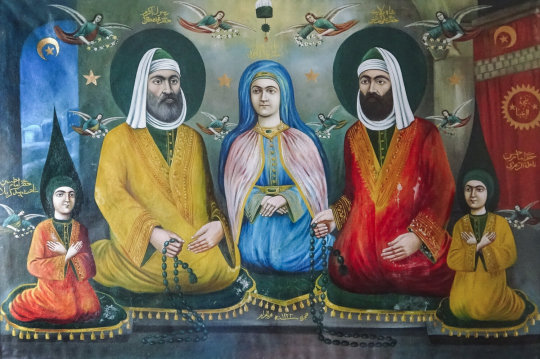
Ε. Δεν υπάρχει το Ισλάμ ως θρησκεία χωρίς τις ιστορικές ισλαμικές επιστήμες
Πολλοί μουσουλμάνοι θα με ώκτειραν γι' αυτό, αλλά η συμπεριφορά τους αυτή θα ήταν δικό τους λάθος και επιπλέον επικύρωση του πρότερου ισχυρισμού μου ότι σήμερα το Ισλάμ, όπως και όλες οι άλλες 'θρησκείες', δεν είναι πλέον μία θρησκεία (ειμή μόνον σε σπάνιες περιπτώσεις χωρικών και απομακρυσμένων κοινοτήτων), αλλά μία ιδεολογία και μάλιστα μία πολιτική ιδεολογία του συρμού (όπως όλες). Είναι πολύ εύκολο να αποδειχθεί με ισλαμικά κριτήρια (και χωρίς την άχρηστη και ανόητη τσιτατολογία που αναίτια παρουσιάζουν όσοι σεΐχηδες και ιμάμηδες λένε ασυναρτησίες) για ποιον λόγο ένας πιστός μιας μονοθεϊστικής θρησκείας, όπως για παράδειγμα η Ουακεφάνα των Ορόμο (45-50 εκ. Κουσιτών της Κατεχόμενης Ορομία, διαιρεμένων ανάμεσα σε Αβησσυνία και Κένυα), δεν χρειάζεται να αποδεχθεί επίσημα το Ισλάμ.
Κατά το Ισλάμ, η έμφυτη θρησκευτική πίστη του Αδάμ ήταν το Ισλάμ, δηλαδή η υποταγή του ανθρώπου στον Θεό. Προφήτες και ιερά βιβλία απεστέλλοντο από τον Θεό σε διάφορους λαούς και έθνη όταν η πίστη τους είχε παρεκκλίνει της αρχικής και αυθεντικής. Συνεπώς, το Ισλάμ, όπως το εκήρυξε ο προφήτης Μωάμεθ, δεν είναι παρά η τελευταία διδασκαλία της ίδιας ακριβώς πίστης-υποταγής στον Θεό και το Κοράνιο είναι το τελευταίο μιας σειράς ιερών βιβλίων αποκαλυφθέντων με Θεία Έμπνευση και Παρέμβαση στον άνθρωπο μέσω απεσταλμένων-προφητών. Έτσι, η ισλαμική θρησκεία αυτόματα εγκαινιάζει την ισλαμική επιστήμη της Ιστορίας, την οποία ανέπτυξαν κορυφαίοι σοφοί και επιστήμονες, συγγραφείς και θεωρητικοί όπως ο Ταμπαρί, ο Αλ Μπαϊρούνι, κοκ.
Όμως, αντίθετα με την ισλαμική επστημονική παράδοση, οι σύγχρονοι ψευτο-μοσυουλμάνοι αποδέχονται στις κίβδηλες θρησκευτικές σχολές τους την δυτική επιστήμη της ιστορίας, αντί να αναπτύξουν και να συνεχίσουν την παραδοσιακή ισλαμική επιστήμη της ιστορίας, η οποία είναι ολότελα διαφορετική. Συνεπώς, για την περίπτωση της απόλυτα μονοθεϊστικής θρησκείας Ουακεφάνα, η οποία κακώς δεν απασχολεί τις ψευτο-θρησκευτικές ισλαμικές σχολές και τα άθλια πανεπιστήμια όλων των μουσουλμανικών χωρών (τα οποία είναι κάκιστα αντίγραφα των δυτικών πανεπιστημίων του υλισμού, του δαρβισνισμού-εξελικτισμού, της αθεΐας και του αγνωστικισμού), σωστοί και καλοπροαίρετοι μουσουλμάνοι ιστορικοί θα πρέπει να αλλάξουν προσέγγιση και στάση, και να την μελετήσουν (και κακώς δεν το έχουν κάνει μέχρι σήμερα) ως μία μορφή Ισλάμ κηρυγμένου στους Κουσίτες προγόνους των σημερινών Ορόμο πριν από το κήρυγμα του προφήτη Μωάμεθ στην Αραβία.
Εναλλακτικά, ένας σύγχρονος μουσουλμάνος ιστορικός, ο οποίος εργάζεται με την μέθοδο των ιστορικών ισλαμικών επιστημών και της ισλαμικής επιστήμης της Ιστορίας, θα μπορεί να εκλάβει την Ουακεφάνα ως ζωντανή συνέχιση του αρχαίου αιγυπτιακού και κουσιτικού (δηλαδή σουδανικού) μονοθεϊσμού, ο οποίος έχει εντοπιστεί σε αρκετές από τις πολλές και διάφορες θρησκείες που αναπτύχθηκαν στην Αρχαία Αίγυπτο και το Κους ('Αιθιοπία' σε αρχαία ελληνικά και λατινικά – μία χώρα ολότελα άσχετη από την σύγχρονη Αβησσυνία/Ψευτο-Αιθιοπία) ήδη από την 3η προχριστιανική χιλιετία. Οπότε, δεν έχει κανένα νόημα να θέλει σήμερα ένας Ορόμο (ή άλλος) μουσουλμάνος να προσηλυτίσει ένα Ουακεφάτα (: οπαδό της Ουακεφάνα) Ορόμο στο Ισλάμ.
Ένας επιπλέον λόγος, για τον οποίο η διάθεση προσηλυτισμού μη μουσουλμάνων είναι ισλαμικώς ανόητη αν όχι κάκιστη, είναι ο εξής: αποτελεί βασική ισλαμική θέση ότι ο οποιοσδήποτε πιστός μιας άλλης θρησκείας σε μία άλλη χώρα μπορεί να έχει ζήσει όλη του την ζωή ως μουσουλμάνος, χωρίς να το ξέρει – είτε έχει απλά ακουστά περί Ισλάμ, είτε αγονεί την ύπαρξη του ισλαμικού κόσμου ολότελα. Αυτό είναι πολύ φυσικό, επειδή κατά το Ισλάμ, η πίστη είναι έμφυτη στον άνθρωπο ήδη από την Δημιουργία και η υποταγή στον Θεό αποτελεί φυσική στάση ζωής. Οπότε, όποια και να είναι η θρησκεία ενός ατόμου, κατά το Ισλάμ, αυτό μπορεί να ζήσει όλη του την ζωή ως μουσουλμάνος χωρίς να το ξέρει και να κερδίσει την αιώνια ζωή, χωρίς να έχει μάθει ούτε μισό στίχο του Κορανίου.
Εξάλλου, δεν υπάρχει ποτέ 'νίκη' μιας θρησκείας, διότι αυτό αποτελεί μία απολύτως επιφανειακή και εξωτερική προσέγγιση των ιστορικών περιστάσεων. Ακόμη και αν έτσι χαρκτηριστεί η κοσμική επιβολή μιας θρησκείας σε ένα κάποιο κράτος (όπως του ρωμαϊκού χριστιανισμού στην Ρώμη και του ομεϋαδικού μουσουλμανισμού στην Δαμασκό), αυτό δεν λέει τίποτα. Αν μία θρησκεία έστω υποθετικά 'επιβληθεί' σε ένα κράτος αλλά οι πιστοί επιτελούν άθλια έργα, νοιάζονται για το υλικό συμφέρον τους, σκοτώνουν όσους ερμηνεύουν διαφορετικά τα ιερά κείμενα, και επίσης προξενούν εμφυλίους πολέμους, αυτό δεν είναι 'νίκη' αλλά 'ήττα' και 'ξεπεσμός' της θρησκείας.
Άλλωστε, τι νόημα έχει να 'νικήσει' και να 'επιβληθεί' σε ένα κράτος μία θρησκεία την οποία οικτρώς παρερμηνεύουν και αλλοιωμένα εφαρμόζουν οι πιστοί της; Αυτό είναι είτε υποκρισία είτε τραγέλαφος! Είναι προτιμώτερη μία βουδιστική χώρα με ηθικούς βουδιστές παρά μία εξισλαμισμένη, πρώην βουδιστική, χώρα με ανήθικους μουσουλμάνους.
Και πως μπορεί να 'νικήσει' ποτέ μία θρησκεία, εφόσον η μόνη πραγματική πίστη είναι έμφυτη στον άνθρωπο, δηλαδή μία κατάσταση την οποία όρισε ο Θεός. Βεβαίως και υπάρχει 'νίκη' του Καλού ή του Κακού, κάθε φορά που ένας άνθρωπος κάνει κάτι το καλό ή κάθε φορά που ένα άτομο επιτελεί κάτι το κακό, αλλά αυτό το συμβάν δεν έχει καμμία σχέση με την όποια θρησκεία πρεσβεύει το συγκεκριμένο άτομο, και ακόμη περισσότερο, αυτό δεν έχει σχέση με το νόημα που έχει η λέξη 'θρησκεία' και το όνομα 'Ισλάμ' κατά το Ισλάμ.
Συνεπώς, αν το τάδε ή το δείνα άτομο αποδέχθηκε το Ισλάμ, ή την Χριστιανωσύνη, ή μία άλλη θρησκεία, αυτό δεν σημαίνει τίποτα παραπάνω από το ότι το συγκεκριμένο συμβάν ή η αλλαγή αυτή ήταν κάτι το σημαντικό και απαραίτητο για το εν λόγω άτομο. Άλλωστε, η θρησκεία είναι μία ολότελα προσωπική υπόθεση και δεν υπάρχει καταναγκασμός στην θρησκεία {لا إكراه في الدين/λα ικράχα φι' ντ-ντιν: Κοράνιο, κεφάλαιο (σούρα) δεύτερο, Αλ Μπάκαρα/Η Αγελάδα; στ. 256}. Ωστόσο, πολλοί μουσουλμάνοι και πολλοί νεοφώτστοι θεωρούν υποχρέωσή τους να παρουσιάζουν μακροσκελείς καταλόγους 'επιφανών' ανθρώπων που αλλαξοπίστησαν και δέχθηκαν την πίστη την οποία αποδέχθηκαν και οι ίδιοι. Αυτό είναι μία επιπλέον επιβεβαίωση του πρότερου ισχυρισμού μου ότι οι θρησκείες έχουν σήμερα καταντήσει ιδεολογίες. Και ναι! Βέβαια! Αντίθετα από τις θρησκείες, οι ιδεολογίες μπορούν και 'νικούν', επειδή οι οπαδοί της μιας καταφέρνουν να συγκεντρώσουν 57% στις εκλογές, ενώ οι τυχόν αντίπαλοι περιορίζονται στο 43%, ή και ακόμη παρακάτω. Αλλά αυτό δεν μπορεί να έχει σχέση με μία θρησκεία και με τις επιταγές του ψυχικού σύμπαντος.
Προσωπικά, βρίσκω αυτή την τάση ως μάλλον αστεία. Τι σημασία μπορεί να έχει το γεγονός ότι ο Γάλλος φιλόσοος Ροζέ Γκαρωντύ (1913-2012) αποδέχθηκε το Ισλάμ, όταν τόσο κορυφαίοι επιστήμονες, επικοί ποιητές, ή υπερβατικοί μύστες και συγγραφείς, όπως ο Αλ Μπαϊρούνι (973-1050), ο Φερντοουσί (940-1020), ή ο Μοχυιελντίν Ιμπν Άραμπι (1165-1240), ήταν μουσουλμάνοι; Είναι κωμικό να συγκρίνει κάποιος τέτοια μεγέθη. Η τάση αυτών των μουσουλμάνων να δίνουν σημασία στο ποιος δυτικός αποδέχθηκε το Ισλάμ είναι προϊόν έντονου εκδυτικισμού, ξενοδουλείας, δυτικολαγνείας, και ασυνείδητης αποδοχής του ψέμματος του τάχα 'δυτικού πολιτισμού' εκ μέρους επιφανειακά μόνον πιστών μουσουλμάνων των οποίων η θρησκεία είναι απλά ένα ιδεολόγημα, αντίθετο στον κομμμουνισμό, τον σοσιαλισμό, και τον νεοφιλελευθερισμό.

Επίλογος
Έγραψα αυτές τις εισαγωγικές σκέψεις χάρη σε ένα πρόσφατο διάλογο που είχα πρόσφατα με ένα Έλληνα φίλο μουσουλμάνο, ο οποίος προ ετών αποδέχθηκε το Ισλάμ. Χάρη στην δυτική, αποικιοκρατική ψευτο-ιστορία, την οποία διδάσκονται όλοι οι μουσουλμάνοι, και εξαιτίας της ξενόδουλης-δυτικόδουλης φύσης των ισλαμιστών και των θρησκευτικών σχολών (μεντρεσά) τους, οι σημερινοί ιδιαίτερα αμόρφωτοι μουσουλμάνοι νομίζουν ότι το αρχικό Ισλάμ διέφερε από την τότε Χριστιανωσύνη, τόσο όσο σήμερα το ισλαμιστικό ιδεολόγημα διαφοροποιείται από το ευαγγελιστικό χριστιανο-σιωνιστικό αφήγημα. Αυτό είναι ολότελα λάθος, Πλέον, γνωρίζουμε πολύ καλά ότι το Ισλάμ είχε τότε θεωρηθεί ως μία επιπλέον χριστιανική αίρεση αρχικά, ένα είδος ριζοσπαστικού νεστοριανισμού.
Στην συζήτησή μας, ετόνισα ότι, αν υπήρχε σήμερα Νεστοριανική Εκκλησία, μπορεί να μην είχα γίνει μουσουλμάνος αλλά νεστοριανός. Αυτό βεβαίως δήλωνε ότι και οι σημερινοί Νεστοριανοί Χριστιανοί είναι κίβδηλοι και συνεπώς ανύπαρκτοι (καθώς έχουν διαβρωθεί από Προστεστάντες και Καθολικούς), και η εγγύτητα του αρχικού, αυθεντικού Ισλάμ (όχι της σημερινής ισλαμιστικής ιδεολογίας) με τον τότε αληθινό Νεστοριανισμό ήταν εντυπωσιακή.
Γνωρίζοντας ελάχιστα το ο,τιδήποτε σχετικό με τον Νεστοριανισμό ως δόγμα, την Ιστορία του Νεστοριανισμού, και την Ιστορία των Πρώιμων και Μέσων Ισλαμικών χρόνων, ο νεοφώτιστος μουσουλμάνος φίλος μου με αφέλεια και απερισκεψία μου απάντησε ότι υπάρχουν και σήμερα Νεστοριανοί, όπως και ότι υπάχουν ακόμη και Μάρτυρες του Ιεχωβά. Αυτό είναι βέβαια ολότελα κωμικό διότι πρόκειται για μία σύγχρονη οργάνωση ολότελα μακράν του αυθεντικού κόσμου του 7ου-13ου αιώνα, από τον οποίο ο συνομιλητής μου ούτε καν υποψιάζεται πόσο απέχει, νομίζοντας ότι υπάρχουν τάχα σήμερα μουσουλμάνοι ή χριστιανοί.
Το πιο αστείο ήταν μάλιστα ότι με παρέπεμψε στο μπλογκ ενός άλλου Έλληνα μουσουλμάνου και στην εκεί ανάρτηση σχετικά με την προσχώρηση (πριν από ένα αιώνα) ενός Αραμαίου Νεστοριανού της Ουρουμίγιε (ΒΔ Ιράν), του Νταβίντ Κελντάνι, στο Ισλάμ. Καθώς έχω ζήσει στην Ουρουμίγιε και γνωρίζω Νεστοριανούς της Ουρουμίγιε του απάντησα και θα δημοσιεύσω αμέσως μετά, ξεχωριστά, την απάντησή μου (καθώς και το δημοσίευμα στο οποίο με παρέπεμψε), αλλά η πιο κωμική διάσταση του θέματος είναι η εξής:
Αντίθετα με τους ασήμαντους και ανίδεους μουσουλμάνους του 21ου αιώνα, οι οποίοι μέσα στην οικτρή κατρακύλα του Ισλάμ θεωρούν αναγκαίο να 'καυχηθούν' επειδή ο Νεστοριανός Αραμαίος Νταβίντ Κελντάνι έγινε μουσουλμάνος στις αρχές του 20ου αιώνα στην Ουρουμίγιε, ο κορυφαίος αστρονόμος Νασρεντίν αλ Τούσι (1201-1274) δεν είχε καμμία ανάγκη ούτε να προσηλυτίσει στο Ισλάμ, ούτε να καυχηθεί ότι επέτυχε κάτι τέτοιο σχετικά με τον Αραμαίο Μονοφυσίτη Χριστιανό επιστήμονα συνεργάτη του στο αστεροσκοπείο της Μαραγέ, τον περίφημο Γρηγόριο Μπαρ Εβραίο (1226-1286), ο οποίος ήταν 'Μαφριάν Καθολικός' (Μονοφυσίτης ‘Αρχιεπίσκοπος’ του Ιράν). Σχετικά:
ttps://www.academia.edu/52098180/Ζιτζ_ε_Σουλτάνι_Αστρικοί_Πίνακες_Ουλούγ_Μπεκ_Νασρεντίν_αλ_Τούσι_κι_η_διαφορά_Σιιτών_Σουνιτών_όπως_ψευδώς_παρουσιάζεται_από_τους_Δυτικούς_Οριενταλιστές
και
ttps://www.academia.edu/52276385/Μαραγέ_το_Αστεροσκοπείο_του_Χουλάγκου_Χαν_στο_Αζερμπαϊτζάν_ο_Αστρονόμος_Νασρεντίν_αλ_Τούσι_η_Πτώση_της_Βαγδάτης_και_το_Τέλος_των_Ασασίνων
και
ttps://www.academia.edu/51962673/Δημήτριος_Αλεξανδρίδης_Ένας_Σημαντικός_Ρωμιός_Μελετητής_του_Έργου_του_Ουλούγ_Μπεκ_Αστρονόμου_Σουλτάνου_του_Τουρκεστάν_Άγνωστος_στην_Ελλάδα_
και
ttps://www.academia.edu/51009792/Ουλούγ_Μπεκ_ο_Αστρονόμος_Σουλτάνος_του_Τουρκεστάν_ο_πιο_Πολυμαθής_Αυτοκράτορας_των_Τελευταίων_2500_Ετών_Εγγονός_του_Ταμερλάνου
Αυτή είναι όλη η ουσία σχετικά με το αληθινό Ισλάμ, το οποίο είναι άγνωστο στην παμψηφία σχεδόν των σημερινών μουσουλμάνων:
Α- είτε παράγεις επιστημονικό, ακαδημαϊκό, μορφωτικό, διανοητικό και πνευματικό έργο αναπτύσσοντας τις αυθεντικές ισλαμικές επιστήμες, οπότε και το Κοράνιο είναι ένα απειροελάχιστο τμήμα των γνώσεών σου, επειδή δεν σου χρειάζεται (δεδομενου ότι οι αρχές του διέπουν ήδη τις επιστήμες τις οποίες διαμορφώνεις χωρίς να δίνεις σημασία στις ψευτο-επιστήμες των άξεστων Δυτικών σατανιστών)
Β- είτε δεν παράγεις έργο, οπότε διαβάζεις και ξαναδιαβάζεις άσκοπα και άχρηστα το Κοράνιο που δεν καταλαβαίνεις, το κάνεις επίκεντρο του κόσμου επειδή δεν θέλεις να μορφωθείς αλλά τεμπελιάζεις, και αποδέχεσαι σαν τυφλός και ηλίθιος άπιστος τις δυτικές ψευτο-επιστήμες, πετώντας έτσι τον ��αυτό οσυ οριστικά εκτός Ισλάμ και βαθειά μέσα στην Κόλαση.
Η πρώτη περίπτωση συνέβαινε στην χρυσή περίοδο του ισλαμικού πολιτισμού και η δεύτερη περίπτωση συμβαίνει σήμερα.
Και τι επιβεβαιώνει το αληθές των λόγων μου καλλίτερα από το γεγονός ότι και οι δυτικοί χείριστοι εχθροί και άθλιοι δυσφημιστές του Ισλάμ και οι ηλίθιοι ψευτο-μουσουλμάνοι ισλαμιστές συμφωνούν ότι τάχα αρκούν το Κοράνιο και οι Χαντίθ για να 'μάθει' κάποιος το Ισλάμ;
Στην πραγματικότητα, χρειάζονται πάνω από χίλια (1000) συγκεκριμένα έργα κορυφαίων μουσουλμάνων σοφών, ιστορικών, λογοτεχνών, επιστημόνων και μυστών των χρόνων της ισλαμικής ακμής για να αρχίσει κάποιος να μαθαίνει το πραγματικό, ιστορικό Ισλάμ (και όχι το σημερινό άθλιο ψευτο-ιδεολόγημα των φανατισμένων πααληρημάτων υπέρ του χετζάμπ και εναντίον του αλκοόλ).
Και, είτε γεννημένος μουσουλμάνος είτε νεοφώτιστος, πριν κάποιος μελετήσει εκατό (100) συγκεκριμένα έργα κορυφαίων μουσουλμάνων σοφών, ιστορικών, λογοτεχνών, επιστημόνων και μυστών των χρόνων της ισλαμικής ακμής, δεν πρέπει να διαβάσει το Κοράνιο διότι αναπόφευκτα θα το καταλάβει ιδιαίτερα εσφαλμένα.
Χωρίς έργα όπως η Ιστορία ή το Ταφσίρ του Ταμπαρί, δεν υπάρχει Κοράνιο για όλους τους μοσυουλμάνους σήμερα. Απλά, όσοι το διαβάζουν έτσι, δεν το καταλαβαίνουν. Και είναι φυσικό.
Ακριβώς όπως και για τον Χέοπα, χωρίς τα κατώτερα και μέσα στρώματα πέτρινων ογκολίθων, δεν θα είχε ποτέ τοποθετηθεί ο λίθος της κορυφής.

#spirituality#proselytism#multiculturalism#religion#theology#ideology#political ideology#political islam#Islam#Nestorianism#Christianity#προσηλυτισμός#προσήλυτοι#Έλληνες μουσουλμάνοι#θρησκεία#θεολογία#πνευματικότητα#πολυπολιτισμικότητα#πολιτικό ισλάμ#Νεστοριανισμός#Ισλάμ
0 notes
Text
Προτάσεις για την Υπέρβαση της Θράκης, του Κοσμά Μεγαλομμάτη – 1990
Προτάσεις για την Υπέρβαση της Θράκης, του Κοσμά Μεγαλομμάτη: Εξόρμηση, 5 Μαρτίου 1990; Πολιτικά Θέματα, 2-8 Μαρτίου 1990; Οικονομικός Ταχυδρόμος, Ιούλιος 1990
Proposals to transcend the problem in Thrace, by Cosmas Megalommatis: Exormisi (Sortie), 5 March 1990; Politika Themata (Political Matters), 2-8 March 1990; Oikonomikos Tahydromos (Economic Courier), July 1990
Предложения по преодолению проблемы во Фракии, автор Космас Мегаломматис: Exormisi (Вылазка), 5 марта 1990 г.; Политика Фемата (Политические вопросы), 2–8 марта 1990 года; Ойкономикос Тагидромос (Экономический курьер), июль 1990 г.
----------------------
Μικρό Εισαγωγικό Σχόλιο
Αυτό το μικρό κείμενο, το οποίο δημοσιεύθηκε πριν από 33 χρόνια, αποκαλύπτει όλη την άθλια πραγματικότητα και την οικτρή κατρακύλα του νεοελληνικού ψευτο-κράτους, δηλαδή ενός εσμού δουλικών, αμορφώτων, αξέστων και ηλιθίων αυτιστικών, τα οποία αυτοκτονικά αυτο-προβάλλονται ως ειδικοί σε θέματα για τα οποία είναι ανίδεοι, και των οποίων ο γελοίος νεοφιλελευθερισμός, ο παρανοϊκός πατριωτισμός, ο παράλογος διεθνισμός, ο γελοίος μοντερνισμός και ο διεστραμμένος δικαιωματισμός έχουν μόνον ένα κοινό παρονομαστή: την διάβρωση, την διάλυση και τε΄λικά την εξαφάνιση της χώρας. Με άλλα λόγια, όλοι τους αποτελούν ένα δικτατορικό καθεστώς το οποίο μισεί την Αλήθεια. Υπό αυτή την άποψη, η κατάσταση στην Θράκη επιδεινώθηκε στο μεσοδιάστημα και κανένας στην τυφλή Ελλάδα δεν έχει ιδέα για το τι πρέπει η χώρα να κάνει ώστε ενεργώς να εντάξει όλους τους κατοίκους της Δυτικής Θράκης στην εξέλιξη και διακυβέρνηση της χώρας, έτσι τερματίζοντας ξενικές επιρροές και αναμείξεις. Οπότε, οι όποιοι εχθροί και οι μη εχθροί της χώρας δεν έχουν καμμιά ανάγκη να κάνουν την παραμικρή κίνηση εναντίον της Ελλάδας, όπως οι ψευτο-πανεπιστημιακοί λούστροι των τηλεοπτικών καναλιών και των παναθλίων ιντερνετικών 'αναλύσεων' βλακωδώς διατείνονται και οι αποβλακωμένοι Νεοέλληνες συνεχώς τους ακούουν, χωρίς να αντιλαμβάνονται ότι είναι θύματα απατεώνων και ψευτών. Ουσιαστικά, κανένας δεν αποπειράται να κόψει κάτι το σάπιο. Αυτό πέφτει από μόνο του.
----------------------------------
Brief Introductory Comment
This little text, which was published 33 years ago, reveals the miserable reality and the severe collapse of the neo-Greek pseudo-state, which is a realm of servile, uneducated, worthless and idiotic autistics, who self-destructively present themselves as experts on subjects in which they are ignorant. Those guys' ridiculous neoliberalism, paranoid patriotism, irrational globalism, ridiculous modernism, and perverse human-rightism have only one common denominator: the erosion, disintegration and forthcoming disappearance of the country. In other words, all of them make one dictatorial regime that hates the Truth. In this view, the situation in Thrace has worsened in the meantime, and no one in the blind country of Greece has any idea what the state should do to actively incorporate all the inhabitants of Western Thrace in the management and governance of the country, thus putting an end to foreign interference. Therefore, the enemies and the non-enemies of the country have no need to make the slightest move against Greece, as the local pseudo-academic rascals stupidly assert. They are all bribed to be incessantly vociferous on TV channels and to absurdly prattle on the web, diffusing bogus-patriotic nonsense and besotting the average Modern Greeks, who by constantly listening to them, become the victims of fraudsters and liars, without even understanding it. In fact, no one is trying to cut something rotten; it falls by itself.
------------------------------------------------
Краткий вводный комментарий
Этот небольшой текст, опубликованный 33 года назад, раскрывает печальную реальность и жестокий крах неогреческого псевдогосударства. Это место рабских, необразованных, никчемных и идиотских аутистов, которые саморазрушительно выставляют себя экспертами в предметах, в которых они невежественны. Нелепый неолиберализм, параноидальный патриотизм, иррациональный глобализм, нелепый модернизм и извращенное правозащитное поведение этих ребят имеют только один общий знаменатель: эрозия, распад и предстоящее исчезновение страны. Другими словами, все они составляют один диктаторский режим, ненавидящий Истину. С этой точки зрения, ситуация во Фракии тем временем ухудшилась, и никто в слепой стране Греции понятия не имеет, что должно делать государство, чтобы активно включить всех жителей Западной Фракии в управление страной и поставить прекращение иностранного вмешательства. Поэтому врагам и неврагам страны незачем предпринимать хоть малейшие шаги против Греции, как глупо утверждают местные псевдоакадемические негодяи. Их всех подкупили для того, чтобы они беспрестанно кричали на телеканалах и нелепо болтали в сети, распространяя фальшиво-патриотический бред и одурманивая среднестатистических современных греков, которые, постоянно их слушая, сами того не понимая, становятся жертвами мошенников и лжецов. На самом деле никто не пытается вырезать что-то гнилое; оно падает само.
========================





====================
Κατεβάστε το άρθρο σε PDF / Download the article in PDF / Скачать статью в формате PDF:
#Thrace#Western Thrace#Pomak#Pomaks#Turks#Turkish minority of Western Thrace#Turkish minority of Greece#Θράκη#Δυτική Θράκη#Τούρκοι#Πομάκοι#τουρκική μειονότητα της Ελλάδας#τουρκική μειονότητα#πομακική μειονότητα#μειονότητες στην Ελλάδα
0 notes
Text
Κοσμάς Μεγαλομμάτης, Ενλίλ: Παγκόσμια Μυθολογία-1989
Κοσμάς Μεγαλομμάτης, Ενλίλ: Παγκόσμια Μυθολογία, Ελληνική Εκπαιδευτική Εγκυκλοπαίδεια, 1989
Кузьма Мегаломматис, Энлиль: мировая мифология, Греческая педагогическая энциклопедия, 1989
Kosmas Megalommatis, Enlil: Weltmythologie, Griechische Pädagogische Enzyklopädie, 1989
Kosmas Gözübüyükoğlu, Enlil: Dünya Mitolojisi, Yunan Pedagoji Ansiklopedisi, 1989
قزمان ميغالوماتيس، انلیل : اساطیر جهانی، دایره المعارف آموزشی یونانی، 1989
Côme Megalommatis, Enlil: Mythologie mondiale, Encyclopédie pédagogique grecque, 1989
1989 قزمان ميغالوماتيس، إنليل: الأساطير العالمية، الموسوعة التربوية اليونانية،
Cosimo Megalommatis, Enlil: mitologia mondiale, Enciclopedia pedagogica greca, 1989
Cosimo Megalommatis, Enlil: mitología mundial, Enciclopedia pedagógica griega, 1989
Cosmas Megalommatis, Enlil: World Mythology, Greek Pedagogical Encyclopedia, 1989
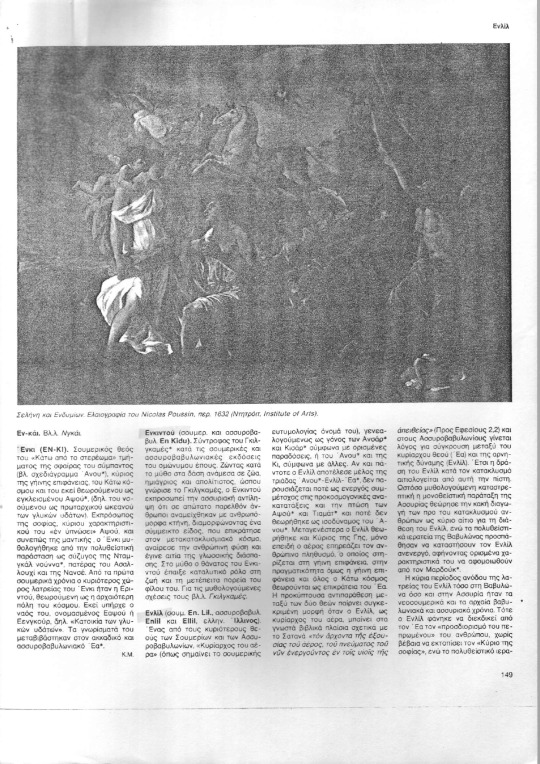
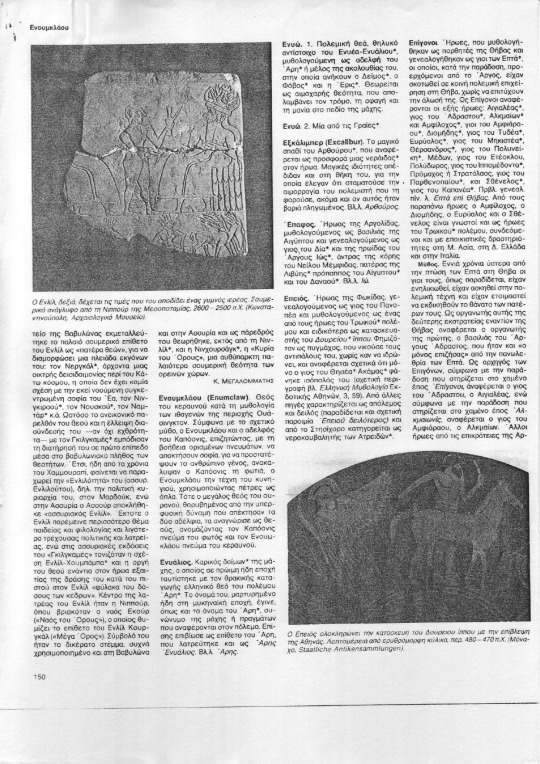
--------------------
Скачать PDF-файл: / PDF-Datei herunterladen: / Télécharger le fichier PDF : / PDF dosyasını indirin: / :PDF قم بتنزيل ملف / Download PDF file: / : یک فایل دانلود کنید / Κατεβάστε το PDF:
#Enlil#Ea#Enki#Anu#Assyrian religions#Assyrian mythology#Babylonian mythology#Sumerian gods#Mesopotamian religions#Ενλίλ#Έα#Άνου#θεοί των Σουμερίων#σουμεριακή μυθολογία#μεσοποταμιακές θρησκείες#βαβυλωνιακή μυθολογία#Νινλίλ
0 notes
Text
Σουννίτες και Σιίτες: στη ρίζα της διαφοράς, του Κοσμά Μεγαλομμάτη
Σουννίτες και Σιίτες: στη ρίζα της διαφοράς, του Κοσμά Μεγαλομμάτη – Εποπτεία 119, Ιανουάριος 1987, σελ. 29-37
Sunnis and Shiites: at the root of the dispute, by Cosmas Megalommatis: Epopteia (‘Overview’) 119, January 1987, p. 29-37
Сунниты и шииты: в основе спора, (автор:) Кузьма Мегаломматис: Эпоптея («Обзор») 119, январь 1987 г., с. 29-37
===============
Σχόλιο
(σχετικά με την ηλεκτρονική αναδημοσίευση του αρχικά προ 36 ετών δημοσιευμένου άρθρου μου) 21 Δεκεμβρίου 2023
Αναδημοσιεύοντας στο Ιντερνέτ αυτό το κείμενο, το οποίο έγραψα περαστικός από την Αθήνα τον Οκτώβριο ή τον Νοέμβριο του 1986, ασφαλώς και εντυπωσιάζομαι. Πριν από 36 χρόνια, είχα ήδη ολοκληρώσει πέντε-έξι χρόνια μεταπτυχιακών σπουδών (σε Παρίσι. Λονδίνο και Βρυξέλλες) ειδικευόμενος σε ασσυριολογία, αιγυπτιολογία, χιττιτολογία, ιρανολογία, μυστηριακές θρησκείες της Ύστερης Αρχαιότητας, Γνώση, Μανιχεϊσμό, θρησκευτικό συγκρητισμό, και καταγωγή των Χριστιανισμών. Είχα ήδη συμπληρώσει τρία χρόνια έρευνας σε Ανατολική Τουρκία, Συρία, Ισραήλ, Ιράκ, Ιορδανία, Κουβέιτ, και Ιράν, ετοιμάζοντας την διδακτορική διατριβή μου στην (Δυτική) Γερμανία. Και είχα μόλις αρχίζει να μελετώ το Ισλάμ, Ισλαμική Ιστορία, ισλαμικές επιστήμες, τέχνες, σοφία και μυστικισμό, ξεκινώντας με μαθήματα στη Σχολή (Μεντρέσα) Σουχάντα του Αγιατολλάχ Γιάχγυα Αλαμέχ Νουρί (σχετικά: https://www.bbc.com/persian/iran/story/2008/01/080119_mf_nouri; σε φαρσί).
Όταν λοιπόν έγραψα αυτό το άρθρο, είχα παύσει να είμαι χριστιανός ορθόδοξος και ήμουν άθρησκος πολίτης της Ελλάδας (επισήμως – αυτό αναφερόταν στην ταυτότητά μου). Είχα αρχίσει να εξοικειώνμαι με το Ισλάμ ως λαϊκή θρησκεία και καθημερινή ζωή, δοξασίες και λατρεία, είχα αρχίσει να αντιλαμβάνομαι το χάος που χωρίζει από την ιστορική αλήθεια και τους δυτικούς ισλαμολόγους και τους μουσουλμάνους θεολόγους, και είχα αρχίσει να καταλαβαίνω το πόσο πολυδιάστατο ιστορικό θέμα είναι το Ισλάμ. Αλλά σε καμμία περίπτωση τότε δεν θα πίστευα ότι μόλις έξι χρόνια μετά την συγγραφή του εν λόγω άρθρου εκ μέρους μου θα αποδεχόμουν το Ισλάμ και θα γινόμουν μουσουλμάνος. Μάλλον θα γελούσα, αν κάποιος μου έλεγε τότε κάτι τέτοιο, έτσι προφητεύοντας το μέλλον.
Εκείνη η περίοδος χαρακτηρίστηκε από την τάση μου να πάρω ίσες αποστάσεις από τα πάντα, ώστε να εξουδετερώσω ξένες επιδράσεις επάνω μου και να δω την ιστορική εξέλιξη αντικειμενικά και ψυχρά, ή μάλλον (για να είμαι ακριβής) ζεστά, δηλαδή αγαπώντας το αντικείμενο της έρευνας και της μελέτης μου. Έτσι, απόλυτα εκτιμωντας το βάρος της ιστορικής παράδοσης της Ανατολής (δηλαδή Μεσοποταμία, Αίγυπτος, Ανατολία, Χαναάν, και Ιράν), το οποίο πέρασε μέσα στο τότε κυοφορούμενο Ισλάμ, κατάφερα να διακρίνω και να επισημάνω την ουσία των καταστάσεων και περιστάσεων που προκλήθηκαν γύρω αποό τον προφήτη Μωάμεθ - κάτι το οποίο κανένας δυτικός ισλαμολόγος και κανένας μουσουλμάνος θεολόγος δεν μπόρεσε να εντοπίσει: όταν γύρω από τον ετοιμοθάνατο Μωάμεθ δύο ομάδες πιστών συγκρούονταν για το ποιον θα ακολουθούσαν, 4000 χρόνια σουμεριακής, ακκαδικής, ασσυροβαβυλωνιακής και ιρανικής ιστορίας, παράδοσης, κληρονομιάς, αυτοκρατορικού ουνιβερσαλισμού, και εσχατολογικών προσδοκιών βάρυναν πάνω στις καρδιές και τα μυαλά τους, χωρίς εκείνοι να το αντιλαμβάνονται.
Είμαι λοιπόν σήμερα στα 67 μου πολύ χαρούμενος βλέποντας ότι στα 30 μου, με λίγο Ταμπαρί και λιγώτερο Τερμεζί, είχα καταφέρει να γράψω την επάνω αριστερά παράγραφο της σελίδας 31, η οποία αρχίζει με τις λέξεις: "το περίπλοκο της όλης υπόθεσης". Σήμερα, μουσουλμάνος και όχι άθρησκος, όχι μόνον δεν θα άλλαζα ούτε μία λέξη στην παράγραφο αυτή, αλλά επιπλέον θα έλεγα ότι η παρατήρηση αυτή αποτελεί την μόνη δυνατή βάση αντίληψης, κατανόησης και αποτιμησης του Ισλάμ και της εν γένει κυοφορίας και γέννησής του. Όλα τα άλλα όλων των μουσουλμάνων θεολόγων, αφελών μέσα στην αμορφωσιά και την επιπολαιότητά τους, και όλων των δυτικών ισλαμολόγων, δηλητηριασμένων μέσα στο αντι-χριστιανικό, αντι-ισλαμικό και αντι-θεϊκό μίσος τους, είναι απλώς παιδαριώδη και ασυνάρτητα. Μη βιαστείτε να νομίσετε ότι στην παράγραφο αυτή θα βρείτε όλη την Αλήθεια! Όμως σίγουρα θα βρείτε τους παράλληλους δρόμους τους οποίους πρέπει να βαδίσετε για να φθάσετε.
Υπάρχουν δύο μικρά τυπογραφικά λάθη (τότε τα κείμενα παραδίδονταν ως απλά χειρόγραφα και εύκολα ένα νεοελληνικό υ συγχέεται με ένα ν, σε επισεσυρμένη γραφή, όταν ο γράφων είναι μάλιστα βιαστικός. Όταν μάλιστα η επιμέλεια κειμένου γίνεται από άτομο που δεν κατέχει το θέμα, τότε ένα μικρό λάθος διπλασιάζεται. Οι δύο τελευταίες λέξεις στην πρώτη γραμμή της δεξιάς στήλης στην τελευταία σελίδα πρέπει να αναγνωσθούν ως: «των Χαουαρίτζ». Προφανώς, ο επιμελητής κειμένου, αφού διάβασε το όνομα ως «Χαοναρίτζ» (η σειρά «αουα» θα φάνηκε ως κάτι το πολύ ξενικό για ένα Νεοέλληνα), το εξέλαβε ως όνομα άνδρα, ενώ είναι όνομα ομάδας: οι Χαουαρίτζ (Khawarij ή Kharijites/ الخوارج).
Σήμερα, 36 χρόνια μετά, παρά τον αναγκαστικό συγχρωτισμό με μουσουλμάνους (εντός του πλαισίου της παγκοσμιοποίησης) και παρά τις ηυξημένες σχέσεις της Ελλάδας με αρκετά μουσουλμανικά κράτη, η μεροληπτική και τυφλή Ελλάδα των αμόρφωτων ψευτο-πανεπιστημιακών και των άξεστων δήθεν γεωπολιτικών αναλυτών που ξερνάνε απόβλητα και παραλογισμούς στις τηλεοράσεις, στα ραδιόφωνα και στο Ιντερνέτ, η κατάσταση δεν έχει σε τίποτα αλλάξει. Η λέξη «Χαουαρίτζ» φέρνει ελάχιστα αποτελέσματα σε μία online search, και φυσικά δεν υπάρχει καν λήμμα στην ελληνική Wikipedia παρά το γεγονός ότι τα αντίστοιχα λήμματα είναι μεγάλα (Hâricîler/Хариджиты/哈里吉派/خوارج) όπως άλλωστε πρέπει.
------------------------
Comment
(about the online republication of my article, which was originally published before 36 years) 21 December 2023
Republishing on the Internet this text, which I wrote when passing from Athens in October or November 1986, I am certainly impressed. 36 years ago, I had already completed five or six years of postgraduate studies (in Paris, London and Brussels) specializing in Assyriology, Egyptology, Hittitology, Iranology, Late Antiquity mystery religions, Gnosticism, Manichaeism, religious syncretism, and the origins of Christianity. I had already completed three years of research in Eastern Turkey, Syria, Israel, Iraq, Jordan, Kuwait, and Iran while preparing my PhD thesis in (West) Germany. I had just begun to study Islam, Islamic history, Islamic sciences, arts, wisdom & mysticism, starting at the Madrasah Shuhada of Ayatollah Yahya Alameh Nouri (https://www.bbc.com/persian/iran/story/2008/01/080119_mf_nouri; in Farsi).
So, when I wrote this article, I had ceased to be an Orthodox Christian and I was an 'irreligious' Greek citizen (officially; it was mentioned on my identity card). I had started to familiarize myself with Islam at the level of popular religion and daily life, belief and cult; I had begun to perceive the chaos that separates the historical truth from the Western Islamologists and from the Muslim theologians; in addition, I had commenced to fathom what a multidimensional historical subject Islam is. But in no way would I then have thought that just six years after writing the article in question I would accept Islam and become a Muslim. I would have probably laughed if someone had said something like that to me at the time, thus foreseeing the future.
That period was characterized by my inclination to take equal distances from everything, in order to neutralize external influences on me and to see the historical development objectively and 'coldly' (or rather, to put it better, 'warmly'; namely expressing deep love for the object of my research and study). Consequently, comprehensively appreciating the weight of the historical tradition of the Orient (i.e., Mesopotamia, Egypt, Anatolia, Canaan, and Iran), which was introduced into the then-embryonic Islam, I was able to discern and comprehend the essence of all the situations and the circumstances, which arose around the prophet Muhammad - something that no Western Islamologist and no Muslim theologian managed to detect: when around the dying Muhammad two groups of believers clashed over who to follow, 4000 years of Sumerian, Akkadian, Assyrian-Babylonian and Iranian history, tradition, heritage, imperial universalism, and eschatological expectations weighed upon their hearts and minds, without them understanding it.
So, today at 67, I am very happy to see that, when I was 30, having little knowledge of Tabari and even less of al-Tirmidhi, I managed to write a text like that of the top left paragraph of page 31, which begins with the words: "the complexity of the whole affair". Today, being a Muslim and not an irreligious man, not only would I not change a single word in this paragraph, but I would also say that this observation is the only possible foundation for the accurate perception, comprehension and evaluation of Islam, and of the entire process of its inception and emergence. All the rest, said or written by either the Muslim theologians, who are gullible in their ignorance and frivolity, or the Western Islamologists, who are poisoned in their anti-Christian, anti-Islamic and anti-Godly hatred, is just childish and nonsensical. Do not come fast to the conclusion that in this paragraph you will find the entire Truth! All the same, you will definitely find the parallel roads that you have to walk in order to get there.
There are two small typographical errors (at the time, the texts were submitted as manuscripts, and a Modern Greek -u can be easily confused with a -n, in cursive writing, particularly when the author writes fast. When the editing of the text is done by a person, who does not know the subject, then a small error is doubled. The last two words on the first line of the right-hand column on the last page should be read as: "of the Khawarij". Apparently the copy editor, having absolutely misread the name as "Khaonarij" (the sequence "awa" being apparently too alien for a Modern Greek), considered it as the name of a man, whereas it is that of a group: the Khawarij (Khawarij or Kharijites/ الخوارج).
Today, 36 years later, despite the forced acculturation (within the globalization context) and in spite of Greece's increased relations with several Muslim states, the biased and blind Greek state infested with uneducated pseudo-academics and uncouth, fake geopolitical analysts, who spew rubbish and nonsense on TV channels, radio programs, and on the web, the situation has not changed at all. The word " Khawarij", written in Greek, brings up very few results in an online search, and of course, there is not even an entry in the Greek Wikipedia despite the fact that the respective entries are as long (Hâricîler/Хариджиты/哈里吉派/خوارج) as they should be.
----------------------------
Комментарий
(об онлайн-переиздании моей статьи, первоначально опубликованной до 36 лет) 21 декабря 2023 г.
Перепечатывая в Интернете этот текст, который я написал, проезжая из Афин в октябре или ноябре 1986 года, я, конечно, впечатлен. 36 лет назад я уже закончил пять или шесть лет аспирантуры (в Париже, Лондоне и Брюсселе) по ассириологии, египтологии, хеттитологии, иранологии, мистическим религиям поздней античности, гностицизму, манихейству, религиозному синкретизму и истокам христианства. Я уже провел три года исследований в Восточной Турции, Сирии, Израиле, Ираке, Иордании, Кувейте и Иране, одновременно готовя докторскую диссертацию в (Западной) Германии. Я только начал изучать ислам, исламскую историю, исламские науки, искусство, мудрость и мистицизм, начиная с медресе Шухада аятоллы Яхья Аламе Нури (https://www.bbc.com/persian/iran/story/2008/01). /080119_mf_nouri; на фарси).
Итак, когда я писал эту статью, я перестал быть православным христианином и был «нерелигиозным» гражданином Греции (официально это было указано в моем удостоверении личности). Я начал знакомиться с исламом на уровне популярной религии и повседневной жизни, верований и культов; Я начал осознавать хаос, который отделяет историческую правду от западных исламологов и мусульманских богословов; кроме того, я начал понимать, каким многомерным историческим субъектом является ислам. Но ни в коем случае я бы тогда не мог подумать, что всего через шесть лет после написания рассматриваемой статьи я приму ислам и стану мусульманином. Я бы, наверное, рассмеялся, если бы кто-то сказал мне тогда что-то подобное, предвидя таким образом будущее.
Этот период характеризовался моей склонностью отходить от всего на равной дистанции, чтобы нейтрализовать внешние воздействия на меня и видеть историческое развитие объективно и «холодно» (или, лучше сказать, «тепло», а именно выражая глубокую любовь для объекта моего исследования и изучения). Таким образом, всесторонне оценивая вес исторической традиции Востока (т. е. Месопотамии, Египта, Анатолии, Ханаана и Ирана), которая была внедрена в тогда еще зарождающийся ислам, я смог различить и понять суть всех ситуации и обстоятельства, возникшие вокруг пророка Мухаммеда - то, что не удалось обнаружить ни одному западному исламологу и ни одному мусульманскому богослову: когда вокруг умирающего Мухаммеда две группы верующих спорили о том, кому следовать, 4000 лет шумерской, аккадской, ассирийско-вавилонской и иранской истории, традиций, наследия, имперского универсализма и эсхатологических ожиданий легли бременем на их сердца и умы, хотя они этого и не поняли.
Итак, сегодня, когда мне 67 лет, я очень рад это видеть, когда мне было 30, имея мало знаний о Табари и еще меньше об ат-Тирмизи, мне удалось написать текст, подобный верхнему левому абзацу страницы 31, который начинается со слов: «сложность всего дела». Сегодня, будучи мусульманином, а не нерелигиозным человеком, я не только не изменил бы ни одного слова в этом абзаце, но и сказал бы, что это наблюдение является единственно возможным основанием для правильного восприятия, понимания и оценки Ислама, а также всего процесса его зарождения и возникновения. Все остальное, сказанное или написанное либо легковерными в своем невежестве и легкомыслии мусульманскими богословами, либо западными исламологами, отравленными своей антихристианской, антиисламской и антибожественной ненавистью, - это просто ребячество и бессмысленно. Не приходите сразу к выводу, что в этом абзаце вы найдете всю Истину! Тем не менее, вы обязательно найдете параллельные дороги, по которым придется пройти, чтобы туда попасть.
Есть две небольшие опечатки (в то время тексты были представлены в виде рукописей, а новогреческое -u можно легко спутать с -n при рукописном письме, особенно когда автор пишет быстро. Когда редактирование текста делается человеком, который не знает тему текста, тогда небольшая ошибка удваивается. Последние два слова в первой строке правой колонки на последней странице следует читать как: «Хариджитов». Судя по всему, редактор, совершенно неправильно прочитав имя как «Хаонаридж» (последовательность «а-у-а», по-видимому, слишком чужда новогреческому языку), посчитал его именем человека, тогда как это имя группы: хариджитов (хаваридж или хариджитов/الخوارج).
Сегодня, 36 лет спустя, несмотря на насильственную аккультурацию (в контексте глобализации) и несмотря на расширение отношений Греции с несколькими мусульманскими государствами, предвзятое и слепое греческое государство, кишащее необразованными псевдоакадемистами и неотесанными, фальшивыми геополитическими аналитиками, которые извергают чушь на телеканалах, радиопрограммах и в сети, ситуация ничуть не изменилась. Слово «Хаваридж», написанное на греческом языке, дает очень мало результатов при онлайн-поиске, и, конечно, его нет даже в греческой Википедии, несмотря на то, что соответствующие записи такие длинные (Hâricîler/Хариджиты/ 哈里吉派/خوارج), какими они должны быть.
====================

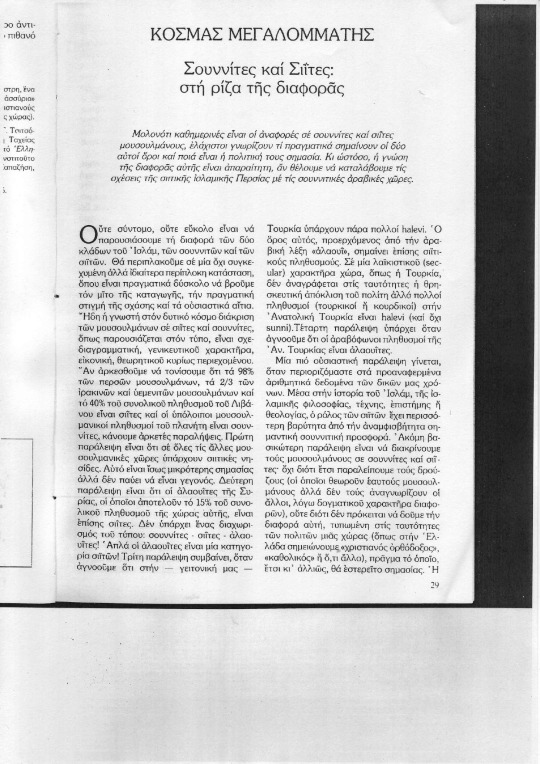








========================
Κατεβάστε το άρθρο σε PDF / Download the article in PDF / Скачать статью в формате PDF:
0 notes
Text
How the international community treated the Islamic Republic of Iran
Η διεθνής αντιμετώπιση της ισλαμικής Περσίας, του Κοσμά Μεγαλομμάτη: Εποπτεία 119, Ιανουάριος 1987, σελ. 38-48
How the international community treated the Islamic Republic of Iran, by Cosmas Megalommatis: Epopteia (‘Overview’) 119, January 1987, p. 38-48
Как международное сообщество относилось к Исламской Республике Иран, (автор:) Кузьма Мегаломматис: Эпоптея («Обзор») 119, январь 1987 г., стр. 38-48

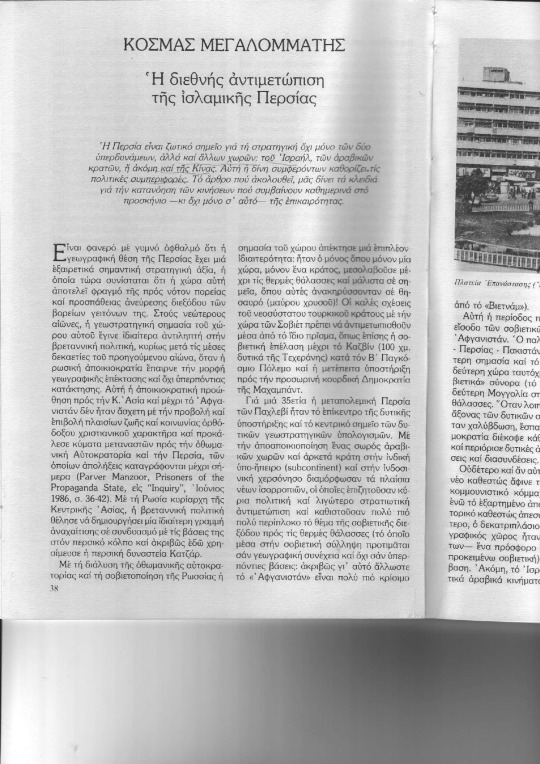
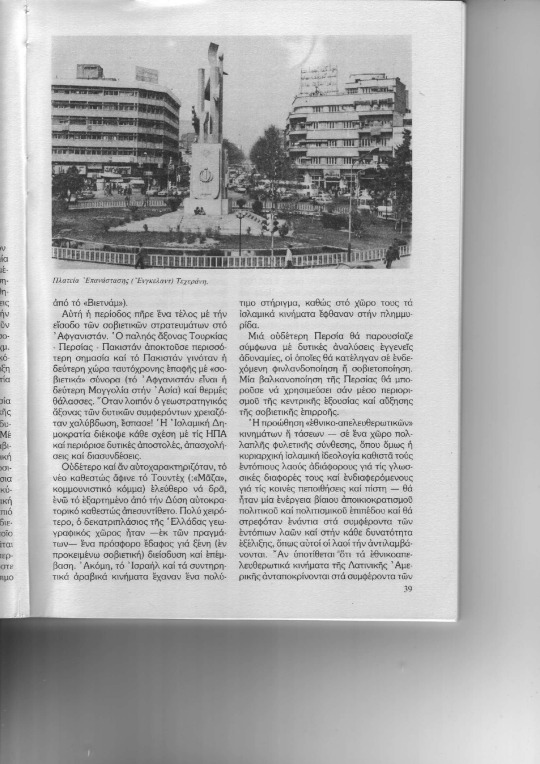


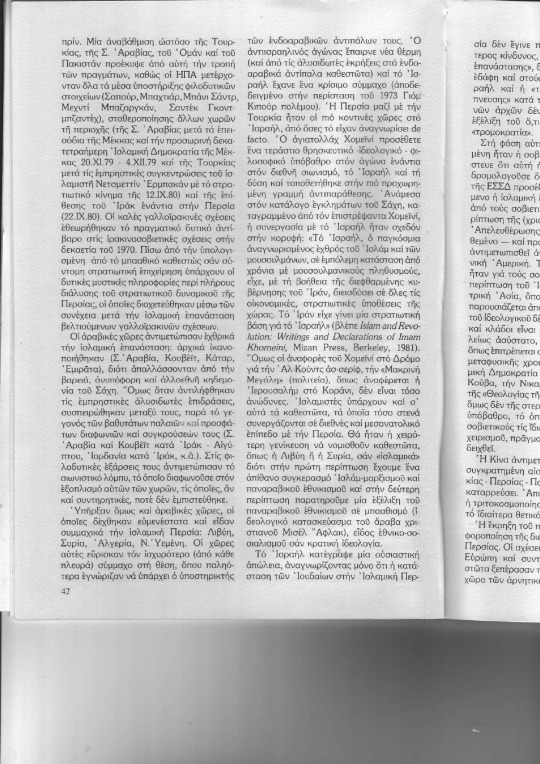





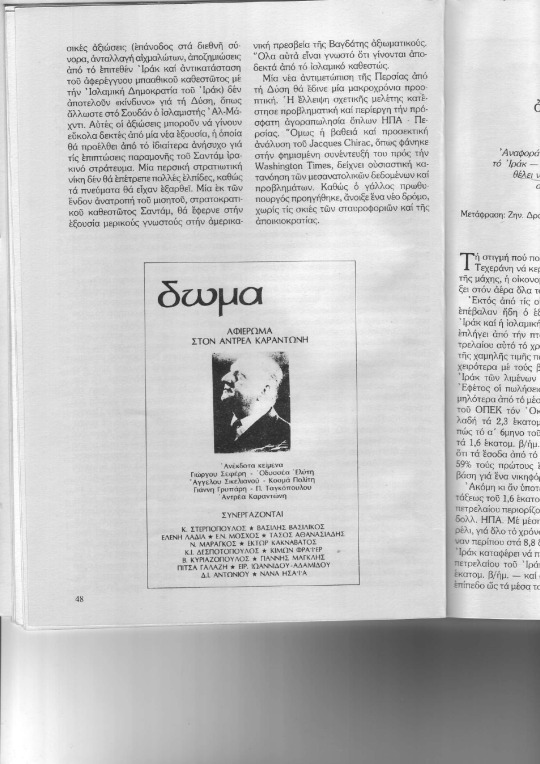
================
Κατεβάστε το άρθρο σε PDF:
#ιράν#iran#persia#Iranian foreign policy#Iran Iraq war#Ιράν#Περσία#Ισλαμική δημοκρατία#περσοϊρακινός πόλεμος
0 notes
Text
Η Πολιτική Ζωή στην Ισλαμική Περσία, του Κοσμά Μεγαλομμάτη-1987
Η Πολιτική Ζωή στην Ισλαμική Περσία, του Κοσμά Μεγαλομμάτη: Εποπτεία 119, Ιανουάριος 1987, σελ. 19-28
Political Life in Islamic Iran, by Cosmas Megalommatis: Epopteia (‘Overview’) 119, January 1987, p. 19-28
Политическая жизнь в исламском Иране, (автор:) Кузьма Мегаломматис: Эпоптея («Обзор») 119, январь 1987 г., с. 19-28
——————————–
Συνήθεις αναγνώστες μου θα παραξενευθούν επειδή χρησιμοποιώ τον όρο ‘Περσία’ αντί ‘Ιράν’ στο συγκεκριμένο άρθρο, καθώς και σε πολλά άλλα άρθρα, εγκυκλοπαιδικά λήμματα, επιστημονικ΄ά άρθρα, και βιβλία δημοσιευμένα στην δεκαετία του 1980 και στις αρχές του 1990. Αυτό οφείλεται στο γεγονός ότι ο όρος αυτός είναι περισσότερο γνωστός και αγαπητός στο ελληνόφωνο αναγνωστικό κοινό, ενώ ο όρος ‘Ιράν’ ακούγεται μάλλον ξενικός. Τότε έγραφα για να πληροφορήσω και να κατατοπίσω σχετικά με θέματα ιστορικού, πνευματικού, θρησκευτικού και πολιτιστικού ενδιαφέροντος σχετιζόμενα με το Ιράν, καθώς και για υποθέσεις επιμελώς αποκρυμμένες σε όλο τον δυτικό κόσμο, όπως επίσης και για δημιουργήσω συμπάθεια προς το Ιράν εναντίον του οποίου στρέφονταν η Δυτική Ευρώπη, το σοβιετικό μπλοκ, οι ΗΠΑ, άλλες δυτικές χώρες, και τα τρισάθλια σκουπίδια των εθελόδουλων κυβερνητών του ανύπαρκτου και ανυπόστατου “αραβικού” κόσμου. Βεβαίως και τότε γνώριζα πολύ καλά ότι ο εξεπίτηδες προτιμώμενος από την μεροληπτική, αποικιοκρατική, δυτική βιβλιογραφία όρος ‘Περσία’ είναι ολότελα λαθεμένος, επειδή το Φαρς (Περσία) αποτελεί μόνον ένα μικρό τμήμα του ιστορικού Ιράν.
Several of my readers may be astounded because I use the term ‘Persia’ instead of ‘Iran’ in this article, as well as in many other articles, entries to encyclopedias, scholarly articles and books published in the 1980s and the early 1990s. This is due to the fact that this term is better known and preferred by the Greek-speaking readership, while the term ‘Iran’ sounds rather foreign to them. At the time, I was writing in order to inform and enlighten about historical, spiritual, religious and cultural topics pertaining to Iran, as well as about matters carefully hidden throughout the Western world, and in order to generate sympathy for Iran against which Western Europe, the Soviet bloc, the USA, other Western countries, and the wretched, docile and useless rulers of the non-existent “Arab” world had formed an alliance. Of course, even then, I was fully aware of the fact that the term ‘Persia’, which is intentionally supported by the biased colonial Western scholarship, is wrong; this is so because Fars (Persia) is only a small part of historical Iran.
Некоторые из моих читателей могут быть удивлены тем, что в этой статье, как и во многих других статьях, записях в энциклопедиях, научных статьях и книгах, изданных в 1980-х и начале 1990-х годов, я использую термин «Персия» вместо «Иран». Это связано с тем, что этот термин более известен и предпочитается грекоязычной читательской аудиторией, а термин «Иран» звучит для них довольно чуждо. В то время я писал, чтобы информировать и просвещать по историческим, духовным, религиозным и культурным темам, касающимся Ирана, а также по вопросам, тщательно скрываемым во всем западном мире, и чтобы вызвать симпатию к Ирану, против которой Западная Европа Советский блок, США, другие западные страны и жалкие, послушные и бесполезные правители несуществующего «арабского» мира образовали союз. Конечно, уже тогда я полностью осознавал тот факт, что термин «Персия», намеренно поддерживаемый предвзятой колониальной западной наукой, неверен; это так, потому что Фарс (Персия) — лишь малая часть исторического Ирана.
-----------------


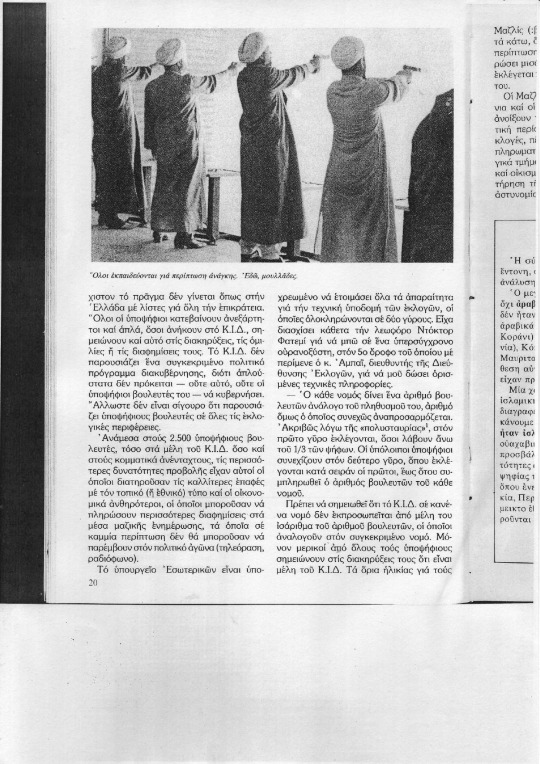
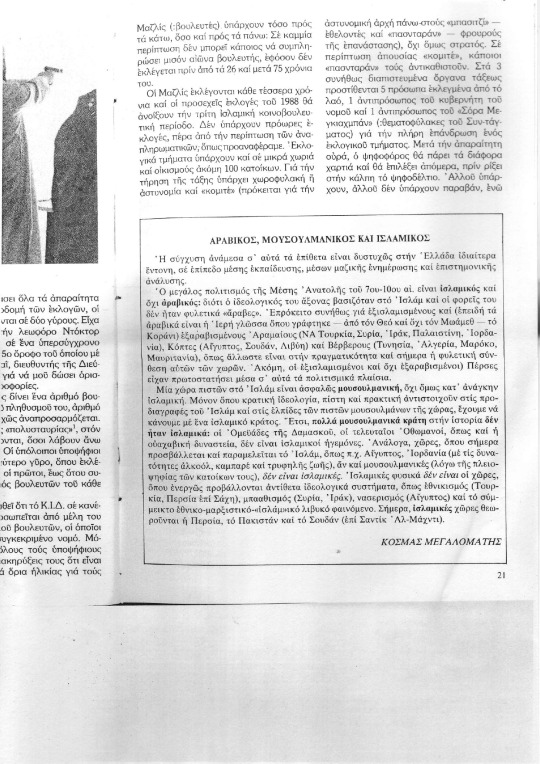


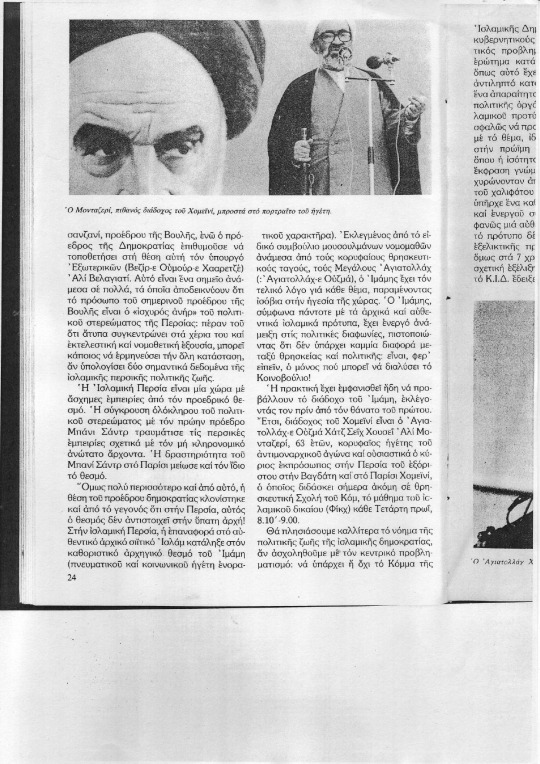


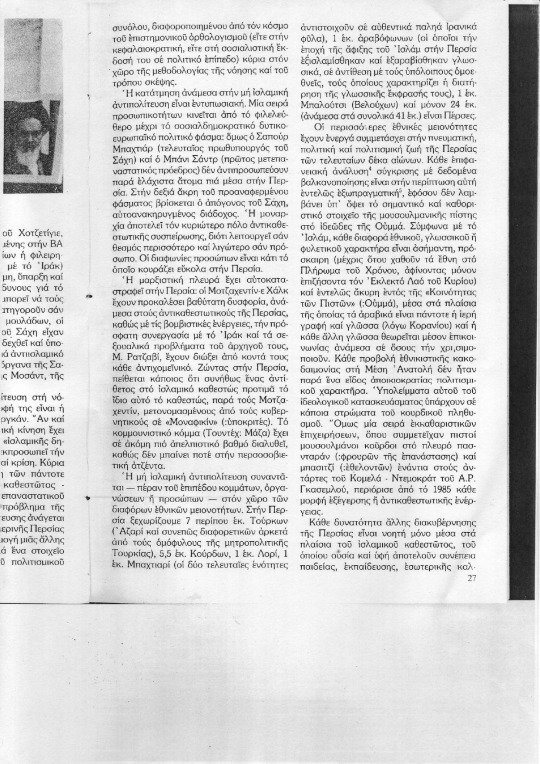
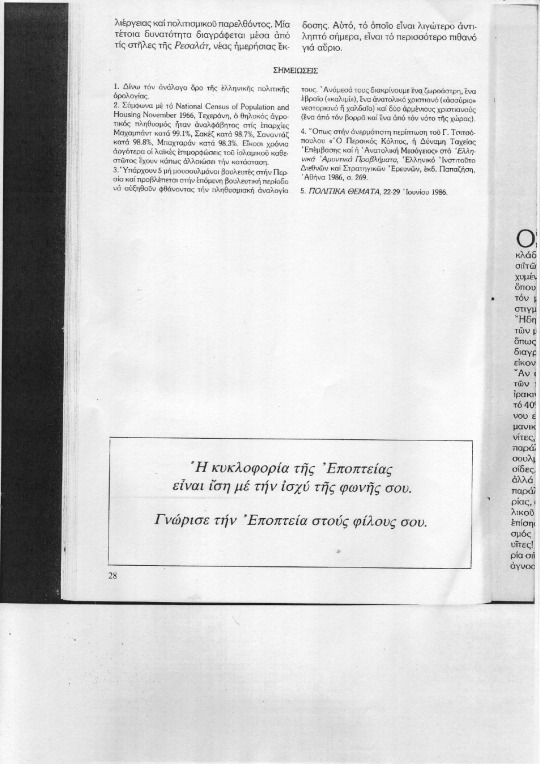
----------------------
Κατεβάστε το άρθρο σε PDF:
#Ιράν#Περσία#περσοϊρακινός πόλεμος#Ισλαμική δημοκρατία#Χομεϊνί#Iran#Persia#Islamic Republic#Ayatullah#Khomeini#Iran-Iraq war
0 notes
Text
Κοσμάς Μεγαλομμάτης, Ουροβόρος: Παγκόσμια Μυθολογία-1989
Κοσμάς Μεγαλομμάτης, Ουροβόρος: Παγκόσμια Μυθολογία, Ελληνική Εκπαιδευτική Εγκυκλοπαίδεια, 1989
Кузьма Мегаломматис, Уроборос (свернувшийся в кольцо змей или дракон, кусающий себя за хвост): мировая мифология, Греческая педагогическая энциклопедия, 1989
Kosmas Megalommatis, Ouroboros oder Uroboros (‘Selbstverzehrer’ oder ‘Schwanzverzehrender’ / eine zusammengerollte Schlange oder ein Drache, der sich in den Schwanz beißt): Weltmythologie, Griechische Pädagogische Enzyklopädie, 1989
Kosmas Gözübüyükoğlu, Ouroboros (kendi kuyruğunu ısıran bir yılan): Dünya Mitolojisi, Yunan Pedagoji Ansiklopedisi, 1989
قزمان ميغالوماتيس، اوروبروس (دُنبخوار/مار یا اژدهایی است که دماش را میخورد): اساطیر جهانی، دایره المعارف آموزشی یونانی، 1989
Côme Megalommatis, Ouroboros (un serpent ou un dragon qui se mord la queue): Mythologie mondiale, Encyclopédie pédagogique grecque, 1989
1989 قزمان ميغالوماتيس، الأوربوروس (الثعبان أو التنين وهو يأكل ذيله.) : الأساطير العالمية، الموسوعة التربوية اليونانية،
Cosimo Megalommatis, Urobòro (chiamato anche uroburo o uroboros o ancora ouroboros / un serpente o un drago che si morde la coda, formando un cerchio senza inizio né fine): mitologia mondiale, Enciclopedia pedagogica greca, 1989
Cosimo Megalommatis, Uróboros (uróboro o ouroboro o uroboro / serpiente que se come la cola): mitología mundial, Enciclopedia pedagógica griega, 1989
Cosmas Megalommatis, Ouroboros (or Uroboros / a serpent or dragon eating its own tail): World Mythology, Greek Pedagogical Encyclopedia, 1989

--------------------
Скачать PDF-файл: / PDF-Datei herunterladen: / Télécharger le fichier PDF : / PDF dosyasını indirin: / :PDF قم بتنزيل ملف / Download PDF file: / : یک فایل دانلود کنید / Κατεβάστε το PDF:
#Ουροβόρος#Γνωστικοί#Γνωστικισμοί#γνωστικιστική κοσμολογία#αρχαία αιγυπτιακή κοσμολογία#Uroboros#Ouroboros#Gnostics#Gnostic cosmology#Ancient Egyptian cosmology
0 notes
Text
Cosmas Megalommatis, Zurvan: World Mythology-1989
Κοσμάς Μεγαλομμάτης, Ζερβάν: Παγκόσμια Μυθολογία, Ελληνική Εκπαιδευτική Εγκυκλοπαίδεια, 1989
Кузьма Мегаломматис, Зерван (Зурван или Зарван): мировая мифология, Греческая педагогическая энциклопедия, 1989
Kosmas Megalommatis, Zurvan (auch Zervan): Weltmythologie, Griechische Pädagogische Enzyklopädie, 1989
Kosmas Gözübüyükoğlu, Zurvan (veya Zervan): Dünya Mitolojisi, Yunan Pedagoji Ansiklopedisi, 1989
قزمان ميغالوماتيس، زروان : اساطیر جهانی، دایره المعارف آموزشی یونانی، 1989
Côme Megalommatis, Zervan (ou Zurvan): Mythologie mondiale, Encyclopédie pédagogique grecque, 1989
1989 قزمان ميغالوماتيس، زورفان: الأساطير العالمية، الموسوعة التربوية اليونانية،
Cosimo Megalommatis, Zurvan (Zurvan Akarana o Zervan Akarana): mitologia mondiale, Enciclopedia pedagogica greca, 1989
Cosimo Megalommatis, Zurvan (o Zervan): mitología mundial, Enciclopedia pedagógica griega, 1989
Cosmas Megalommatis, Zurvan: World Mythology, Greek Pedagogical Encyclopedia, 1989
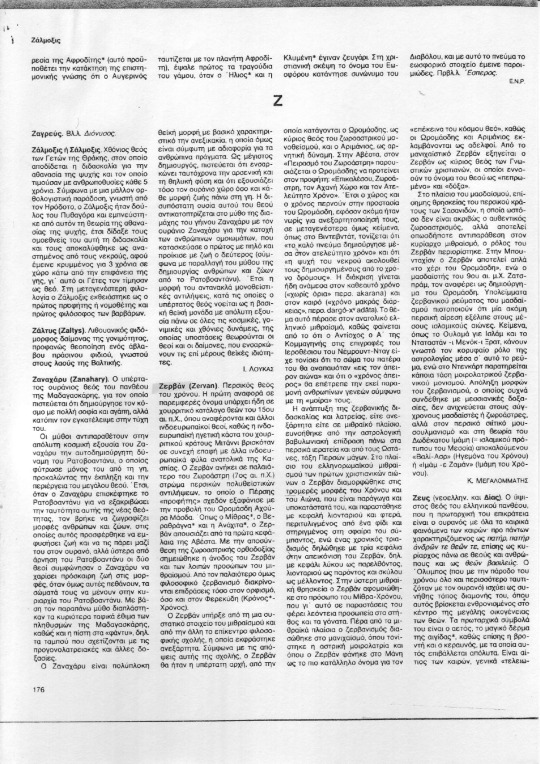
--------------------------
Скачать PDF-файл: / PDF-Datei herunterladen: / Télécharger le fichier PDF : / PDF dosyasını indirin: / :PDF قم بتنزيل ملف / Download PDF file: / : یک فایل دانلود کنید / Κατεβάστε το PDF:
#Ζερβάν#Ζουρβάν#ζερβανισμός#ζωροαστρισμός#μιθραϊσμός#μαζδακισμός#Zervanisme#Zurvanism#Zervan#Zurvan#Iranian religions#Ancient Persian religions
0 notes
Text
Cosmas Megalommatis, Atargatis (or Derceto): World Mythology, Greek Pedagogical Encyclopedia, 1989
Κοσμάς Μεγαλομμάτης, Αταργάτη (ή Δερκετώ): Παγκόσμια Μυθολογία, Ελληνική Εκπαιδευτική Εγκυκλοπαίδεια, 1989
Кузьма Мегаломматис, Атаргатис (или Деркето): мировая мифология, Греческая педагогическая энциклопедия, 1989
Kosmas Megalommatis, Atargatis (oder Dea Syria): Weltmythologie, Griechische Pädagogische Enzyklopädie, 1989
Kosmas Gözübüyükoğlu, Atargatis: Dünya Mitolojisi, Yunan Pedagoji Ansiklopedisi, 1989
قزمان ميغالوماتيس، آتارگاتیس : اساطیر جهانی، دایره المعارف آموزشی یونانی، 1989
Côme Megalommatis, Atargatis (ou Dercéto): Mythologie mondiale, Encyclopédie pédagogique grecque, 1989
1989 قزمان ميغالوماتيس، أترعتا : الأساطير العالمية، الموسوعة التربوية اليونانية،
Cosimo Megalommatis, Atargatide (o Atergate): mitologia mondiale, Enciclopedia pedagogica greca, 1989
Cosimo Megalommatis, Atargatis (o Derceto): mitología mundial, Enciclopedia pedagógica griega, 1989
Cosmas Megalommatis, Atargatis (or Derceto): World Mythology, Greek Pedagogical Encyclopedia, 1989

---------------------
Скачать PDF-файл: / PDF-Datei herunterladen: / Télécharger le fichier PDF : / PDF dosyasını indirin: / :PDF قم بتنزيل ملف / Download PDF file: / : یک فایل دانلود کنید / Κατεβάστε το PDF:
#Αταργάτη#Σύρια Θεά#Δερκετώ#αραμαϊκή θρησκεία#Μανμπίτζ#Ιέραβλος#Τζέραμπλους#Ύστερη Αρχαιότητα#μυστικισμός#θρησκευτικός συγκρητισμός#Atargatis#Derceto
0 notes
Text
Κοσμάς Μεγαλομμάτης, Μαρδούκ: Παγκόσμια Μυθολογία-1989
Κοσμάς Μεγαλομμάτης, Μαρδούκ: Παγκόσμια Μυθολογία, Ελληνική Εκπαιδευτική Εγκυκλοπαίδεια, 1989
Кузьма Мегаломматис, Мардук: мировая мифология, Греческая педагогическая энциклопедия, 1989
Kosmas Megalommatis, Marduk: Weltmythologie, Griechische Pädagogische Enzyklopädie, 1989
Kosmas Gözübüyükoğlu, Marduk: Dünya Mitolojisi, Yunan Pedagoji Ansiklopedisi, 1989
قزمان ميغالوماتيس، مردوک : اساطیر جهانی، دایره المعارف آموزشی یونانی، 1989
Côme Megalommatis, Marduk: Mythologie mondiale, Encyclopédie pédagogique grecque, 1989
1989 قزمان ميغالوماتيس، مردوخ (مرْدُوك) : الأساطير العالمية، الموسوعة التربوية اليونانية،
Cosimo Megalommatis, Marduk: mitologia mondiale, Enciclopedia pedagogica greca, 1989
Cosimo Megalommatis, Marduk: mitología mundial, Enciclopedia pedagógica griega, 1989
Cosmas Megalommatis, Marduk: World Mythology, Greek Pedagogical Encyclopedia, 1989

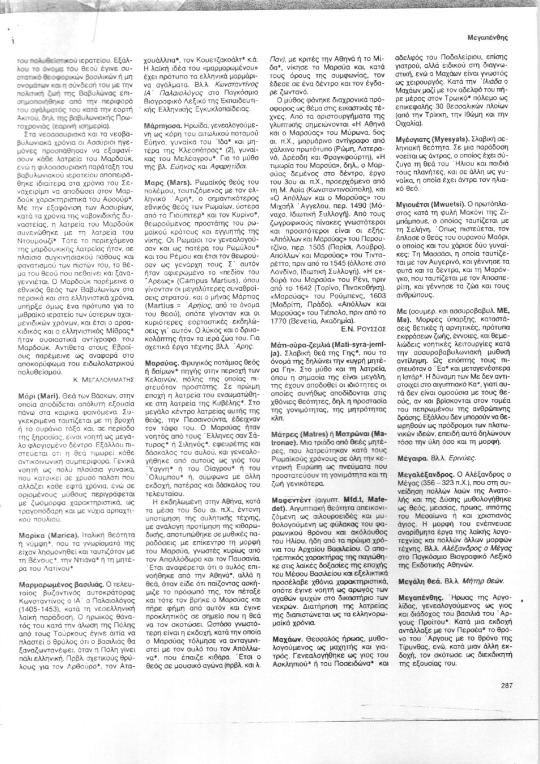
--------------------
Скачать PDF-файл: / PDF-Datei herunterladen: / Télécharger le fichier PDF : / PDF dosyasını indirin: / :PDF قم بتنزيل ملف / Download PDF file: / : یک فایل دانلود کنید / Κατεβάστε το PDF:
#Μαρδούκ#Μαρντούκ#βαβυλωνιακή μυθολογία#μεσοποταμιακές θρησκείες#Babylonian religion#Marduk#Babylonian mythology
0 notes
Text
Cosmas Megalommatis, Ninurta (or Ningirsu or Ninib): World Mythology
Κοσμάς Μεγαλομμάτης, Νινούρτα: Παγκόσμια Μυθολογία, Ελληνική Εκπαιδευτική Εγκυκλοπαίδεια, 1989
Кузьма Мегаломматис, Нинурта (или Ниниб): мировая мифология, Греческая педагогическая энциклопедия, 1989
Kosmas Megalommatis, Ninurta: Weltmythologie, Griechische Pädagogische Enzyklopädie, 1989
Kosmas Gözübüyükoğlu, Ninurta (veya Ningirsu): Dünya Mitolojisi, Yunan Pedagoji Ansiklopedisi, 1989
قزمان ميغالوماتيس، نینورتا : اساطیر جهانی، دایره المعارف آموزشی یونانی، 1989
Côme Megalommatis, Ninurta: Mythologie mondiale, Encyclopédie pédagogique grecque, 1989
1989 قزمان ميغالوماتيس، نينورتا : الأساطير العالمية، الموسوعة التربوية اليونانية،
Cosimo Megalommatis, Ninurta: mitologia mondiale, Enciclopedia pedagogica greca, 1989
Cosimo Megalommatis, Ninurta: mitología mundial, Enciclopedia pedagógica griega, 1989
Cosmas Megalommatis, Ninurta (or Ningirsu or Ninib): World Mythology, Greek Pedagogical Encyclopedia, 1989
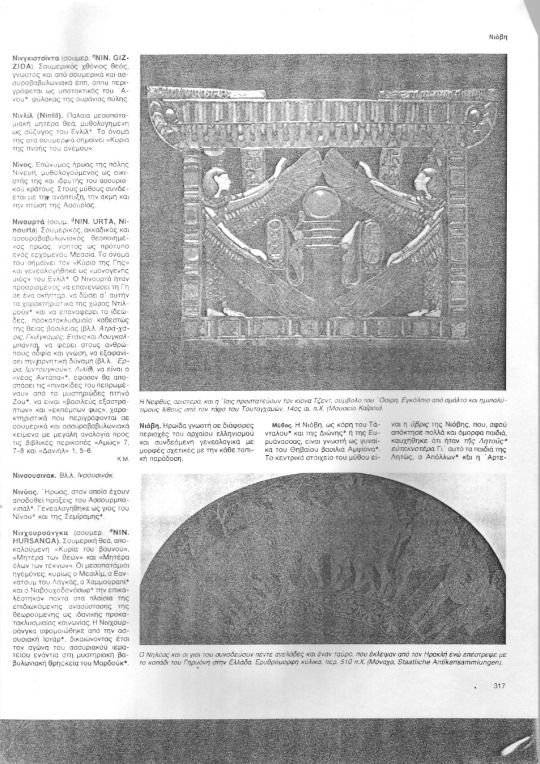
-----------------
Скачать PDF-файл: / PDF-Datei herunterladen: / Télécharger le fichier PDF : / PDF dosyasını indirin: / :PDF قم بتنزيل ملف / Download PDF file: / : یک فایل دانلود کنید / Κατεβάστε το PDF:
#Ninurta#Ningirsu#Ninib#Assyrian Messianism#Messianism#babylonian mythology#Mesopotamian religions#Νινούρτα#Ετάνα#Νινγκιρσού#Μεσσιανισμός#ασσυριακός μονοθεϊσμός#ασσυριακή θρησκεία#ασσυριακός μεσσιανισμός#Νινίμπ#Ιστάρ
0 notes
Text
Κοσμάς Μεγαλομμάτης, Νεργκάλ: Παγκόσμια Μυθολογία-1989
Κοσμάς Μεγαλομμάτης, Νεργκάλ: Παγκόσμια Μυθολογία, Ελληνική Εκπαιδευτική Εγκυκλοπαίδεια, 1989
Кузьма Мегаломматис, Нергал: мировая мифология, Греческая педагогическая энциклопедия, 1989
Kosmas Megalommatis, Nergal: Weltmythologie, Griechische Pädagogische Enzyklopädie, 1989
Kosmas Gözübüyükoğlu, Nergal: Dünya Mitolojisi, Yunan Pedagoji Ansiklopedisi, 1989
قزمان ميغالوماتيس، نرگال : اساطیر جهانی، دایره المعارف آموزشی یونانی، 1989
Côme Megalommatis, Nergal: Mythologie mondiale, Encyclopédie pédagogique grecque, 1989
1989 قزمان ميغالوماتيس، نرغال : الأساطير العالمية، الموسوعة التربوية اليونانية،
Cosimo Megalommatis, Nergal (o Nerigal): mitologia mondiale, Enciclopedia pedagogica greca, 1989
Cosimo Megalommatis, Nergal: mitología mundial, Enciclopedia pedagógica griega, 1989
Cosmas Megalommatis, Nergal: World Mythology, Greek Pedagogical Encyclopedia, 1989

--------------------
Скачать PDF-файл: / PDF-Datei herunterladen: / Télécharger le fichier PDF : / PDF dosyasını indirin: / :PDF قم بتنزيل ملف / Download PDF file: / : یک فایل دانلود کنید / Κατεβάστε το PDF:
#assyria#Nergal#Ereshkigal#Cutha#Nether world#Babylonian religion#Mesopotamian religions#Ασσυριακή θρησκεία#Νεργκάλ#Ερεσκιγκάλ#Σαμάς#Ιστάρ#Κάτω Κόσμος#ασσυριακή κοσμολογία
0 notes
Text
Cosmas Megalommatis, Nabu: World Mythology, Greek Pedagogical Encyclopedia, 1989
Κοσμάς Μεγαλομμάτης, Ναμπού: Παγκόσμια Μυθολογία, Ελληνική Εκπαιδευτική Εγκυκλοπαίδεια, 1989
Кузьма Мегаломматис, Набу: мировая мифология, Греческая педагогическая энциклопедия, 1989
Kosmas Megalommatis, Nabu: Weltmythologie, Griechische Pädagogische Enzyklopädie, 1989
Kosmas Gözübüyükoğlu, Nabu: Dünya Mitolojisi, Yunan Pedagoji Ansiklopedisi, 1989
قزمان ميغالوماتيس، نبو : اساطیر جهانی، دایره المعارف آموزشی یونانی، 1989
Côme Megalommatis, Nabû: Mythologie mondiale, Encyclopédie pédagogique grecque, 1989
1989 قزمان ميغالوماتيس، نابو : الأساطير العالمية، الموسوعة التربوية اليونانية،
Cosimo Megalommatis, Nabu: mitologia mondiale, Enciclopedia pedagogica greca, 1989
Cosimo Megalommatis, Nabu: mitología mundial, Enciclopedia pedagógica griega, 1989
Cosmas Megalommatis, Nabu: World Mythology, Greek Pedagogical Encyclopedia, 1989
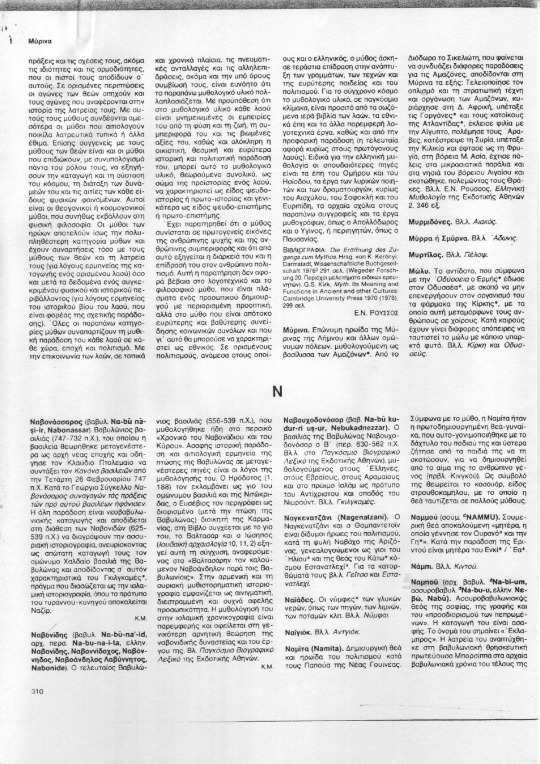

===============
Скачать PDF-файл: / PDF-Datei herunterladen: / Télécharger le fichier PDF : / PDF dosyasını indirin: / :PDF قم بتنزيل ملف / Download PDF file: / : یک فایل دانلود کنید / Κατεβάστε το PDF:
#Ναμπού#ασσυριακή θρησκεία#σοφία#Θεού Σοφία#μεσοποταμιακές θρησκείες#Nabu#Assyrian religion#Wisdom#Wisdom literature
0 notes
Text
Κοσμάς Μεγαλομμάτης, Σιν: Παγκόσμια Μυθολογία
Κοσμάς Μεγαλομμάτης, Σιν: Παγκόσμια Μυθολογία, Ελληνική Εκπαιδευτική Εγκυκλοπαίδεια, 1989
Кузьма Мегаломматис, Син (или Нанна): мировая мифология, Греческая педагогическая энциклопедия, 1989
Kosmas Megalommatis, Sin: Weltmythologie, Griechische Pädagogische Enzyklopädie, 1989
Kosmas Gözübüyükoğlu, Sin: Dünya Mitolojisi, Yunan Pedagoji Ansiklopedisi, 1989
قزمان ميغالوماتيس، سین : اساطیر جهانی، دایره المعارف آموزشی یونانی، 1989
Côme Megalommatis, Sîn: Mythologie mondiale, Encyclopédie pédagogique grecque, 1989
1989 قزمان ميغالوماتيس، سين : الأساطير العالمية، الموسوعة التربوية اليونانية،
Cosimo Megalommatis, Sin (o Nanna): mitologia mondiale, Enciclopedia pedagogica greca, 1989
Cosimo Megalommatis, Sin (Sinai, Nanna, Nannar, Suen o Zuen): mitología mundial, Enciclopedia pedagógica griega, 1989
Cosmas Megalommatis, Sin (or Suen): World Mythology, Greek Pedagogical Encyclopedia, 1989

=================
Скачать PDF-файл: / PDF-Datei herunterladen: / Télécharger le fichier PDF : / PDF dosyasını indirin: / :PDF قم بتنزيل ملف / Download PDF file: / : یک فایل دانلود کنید / Κατεβάστε το PDF:
https://osf.io/wys79
0 notes
Text
Cosmas Megalommatis, Shamash: World Mythology-1989
Κοσμάς Μεγαλομμάτης, Σαμάς: Παγκόσμια Μυθολογία, Ελληνική Εκπαιδευτική Εγκυκλοπαίδεια, 1989
Кузьма Мегаломматис, Шамаш: мировая мифология, Греческая педагогическая энциклопедия, 1989
Kosmas Megalommatis, Šamaš (oder Schamasch): Weltmythologie, Griechische Pädagogische Enzyklopädie, 1989
Kosmas Gözübüyükoğlu, Şamaş: Dünya Mitolojisi, Yunan Pedagoji Ansiklopedisi, 1989
قزمان ميغالوماتيس، شمش : اساطیر جهانی، دایره المعارف آموزشی یونانی، 1989
Côme Megalommatis, Shamash: Mythologie mondiale, Encyclopédie pédagogique grecque, 1989
1989 قزمان ميغالوماتيس، شمش : الأساطير العالمية، الموسوعة التربوية اليونانية،
Cosimo Megalommatis, Šamaš: mitologia mondiale, Enciclopedia pedagogica greca, 1989
Cosimo Megalommatis, Shamash: mitología mundial, Enciclopedia pedagógica griega, 1989

===============
Скачать PDF-файл: / PDF-Datei herunterladen: / Télécharger le fichier PDF : / PDF dosyasını indirin: / :PDF قم بتنزيل ملف / Download PDF file: / : یک فایل دانلود کنید / Κατεβάστε το PDF:
#Σαμάς#Ιστάρ#Σιν#Νεργκάλ#Ασσυριακή θρησκεία#Shamash#Sin#Ishtar#Nergal#Assyrian religion#Babylonian religion#Mesopotamian religions
0 notes